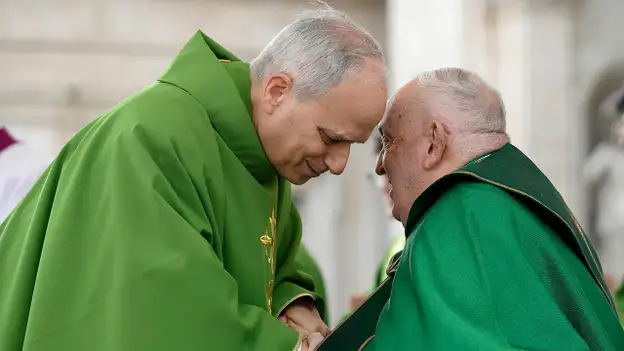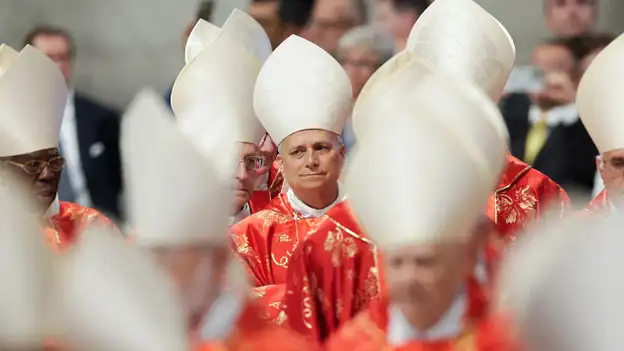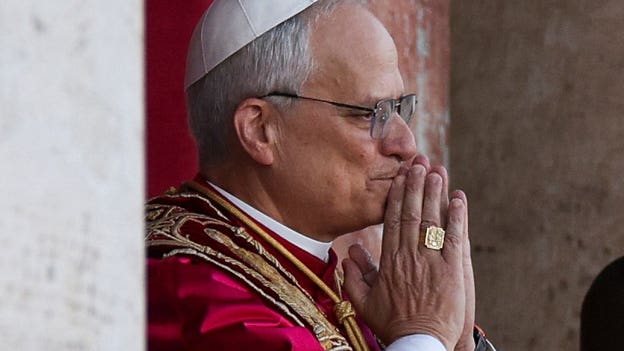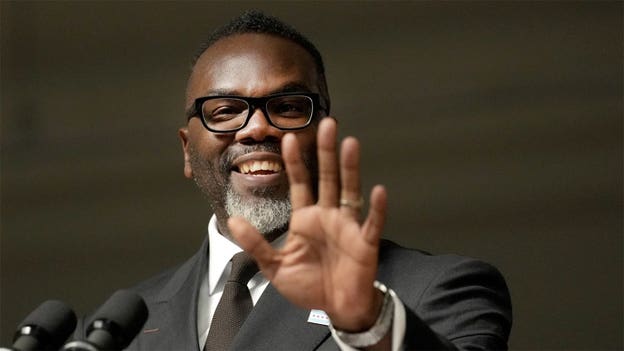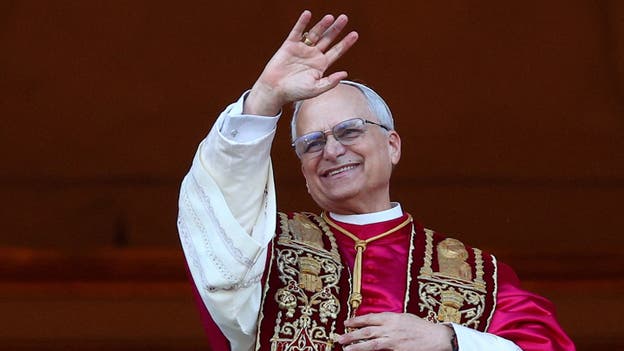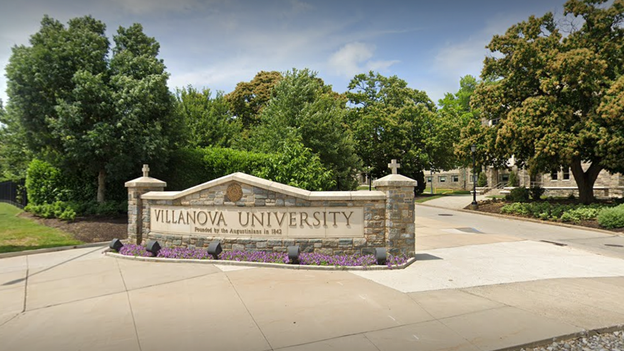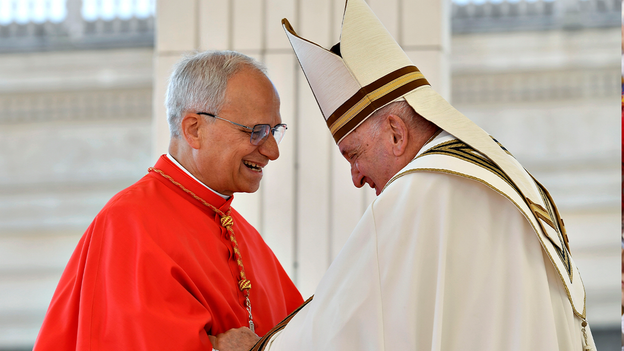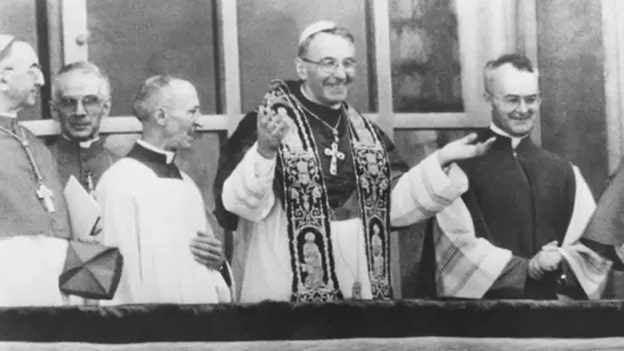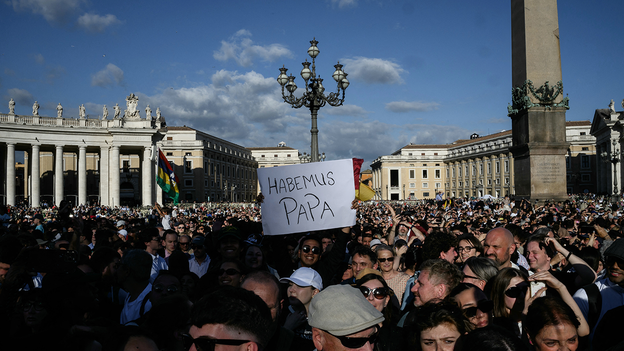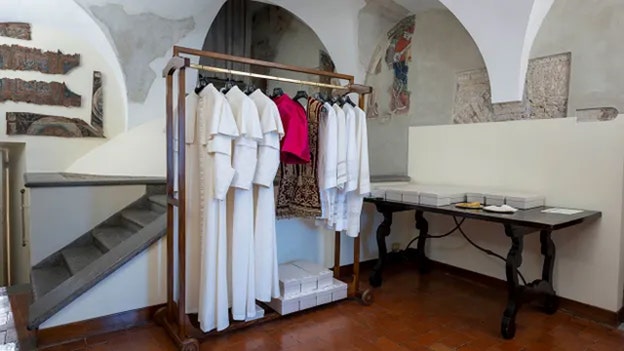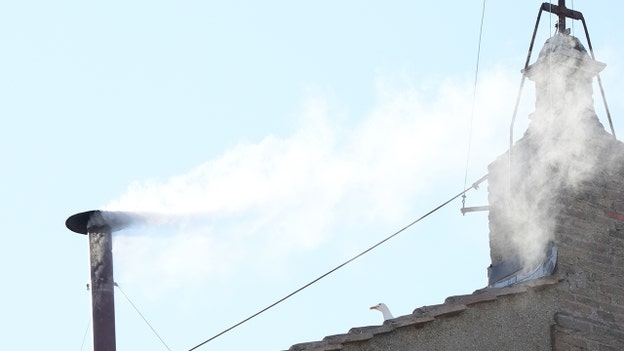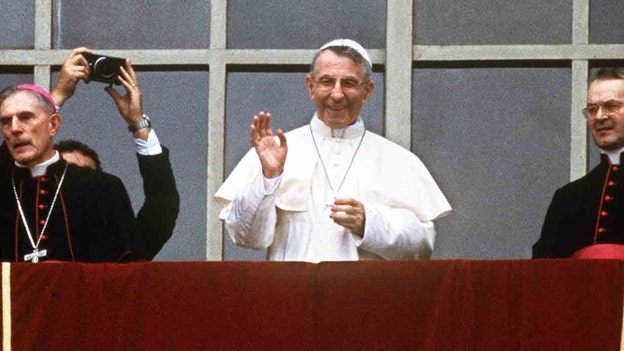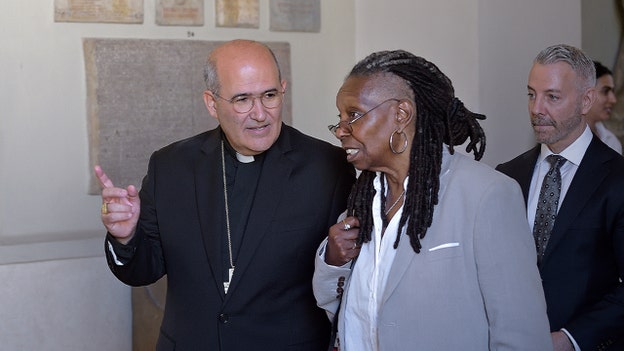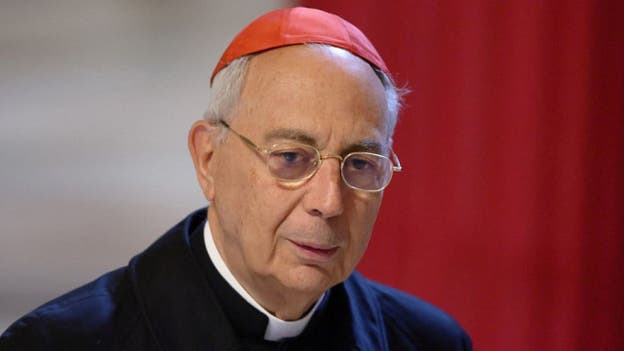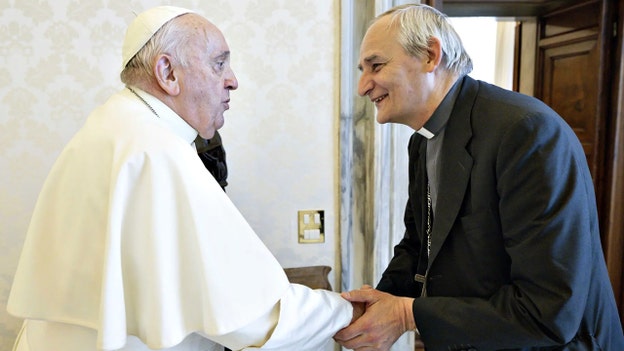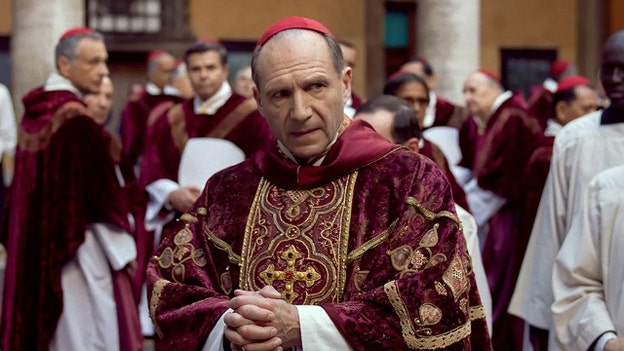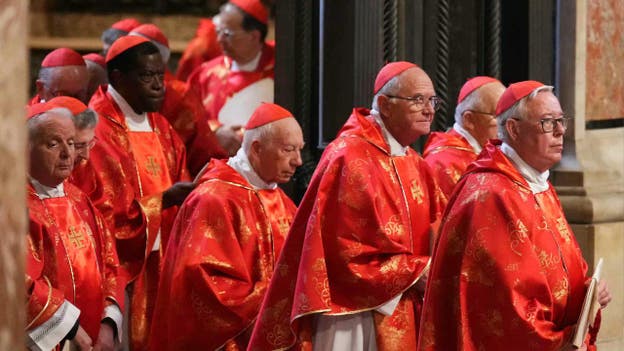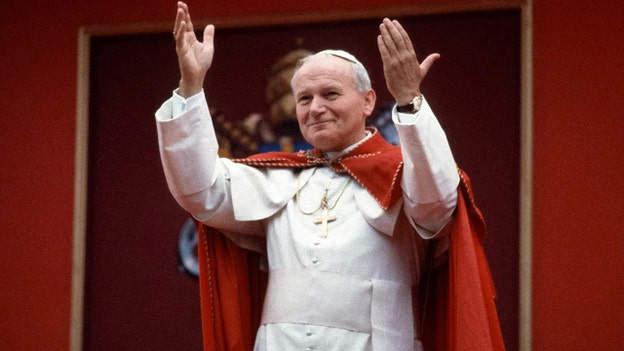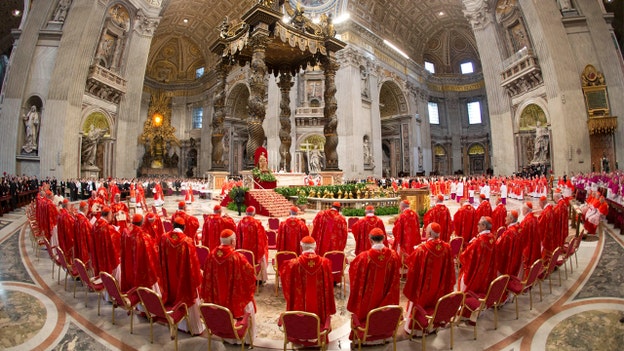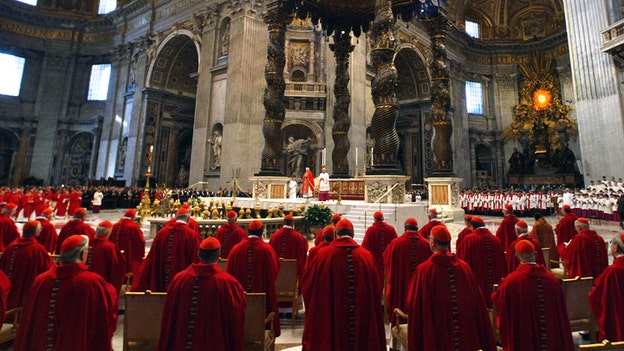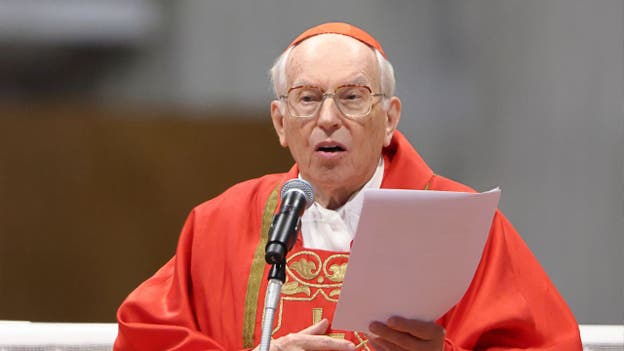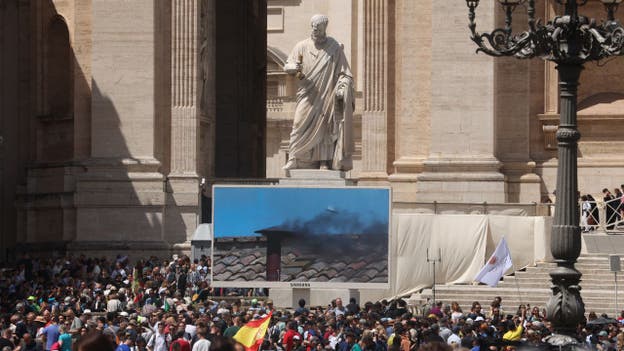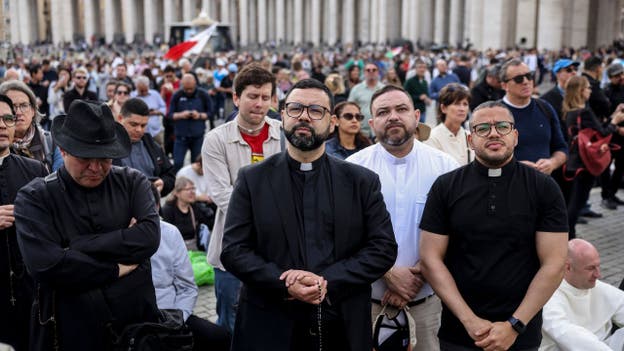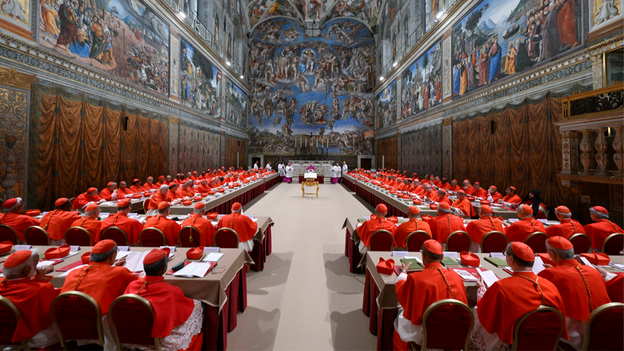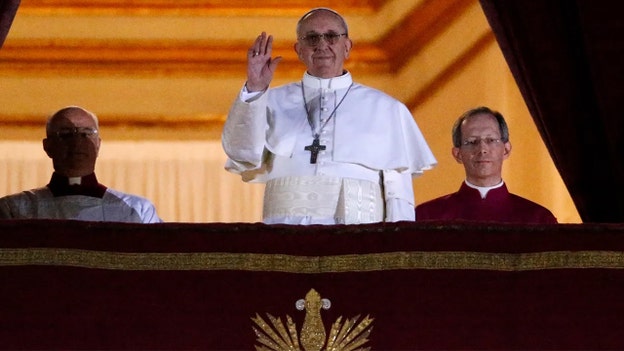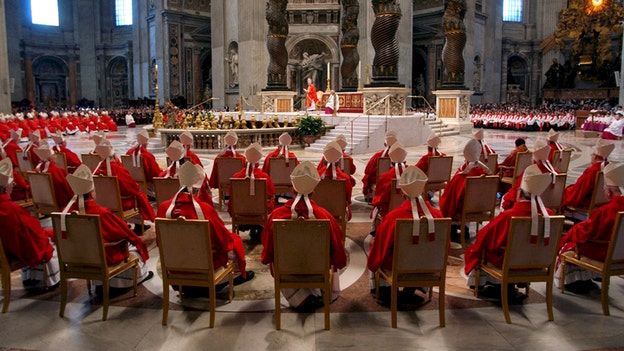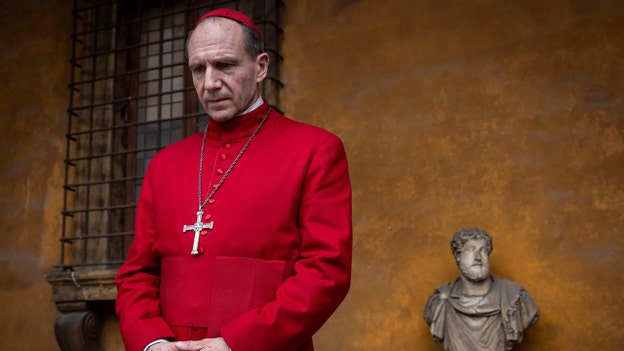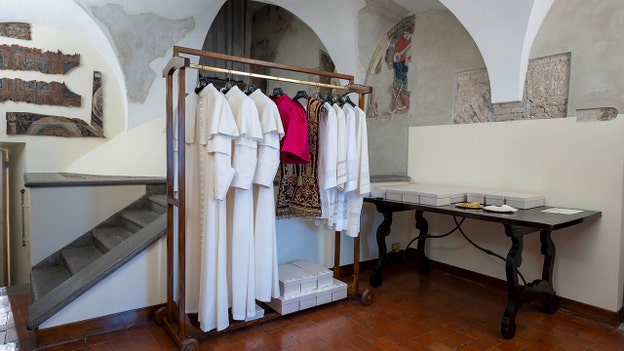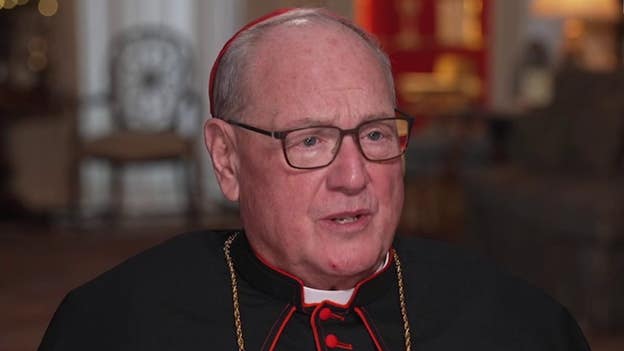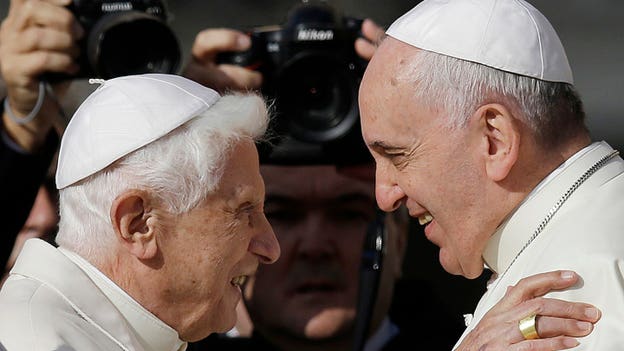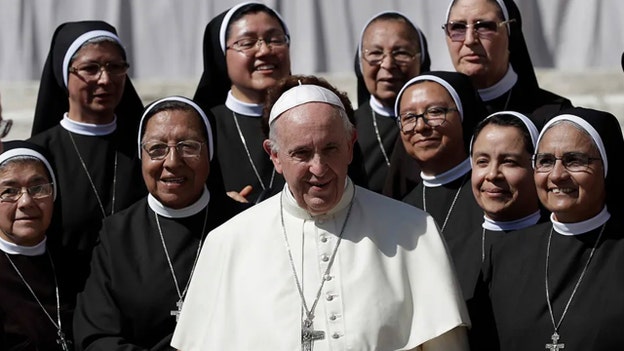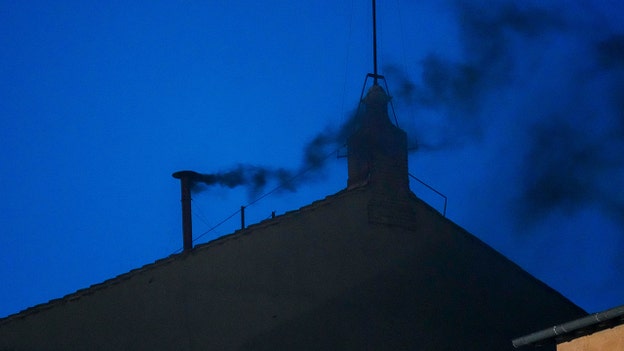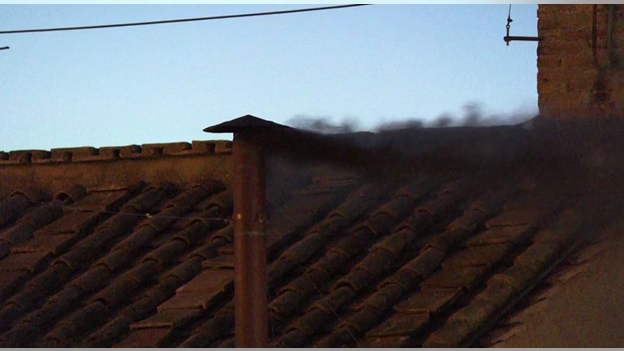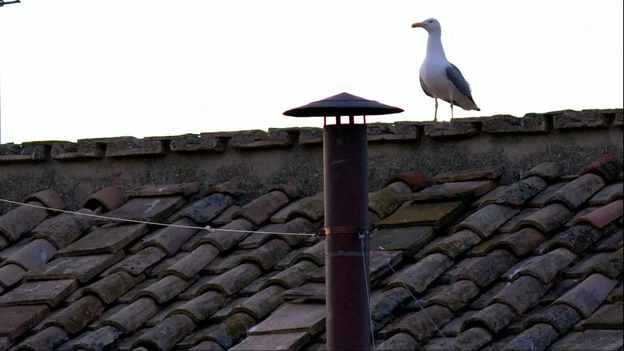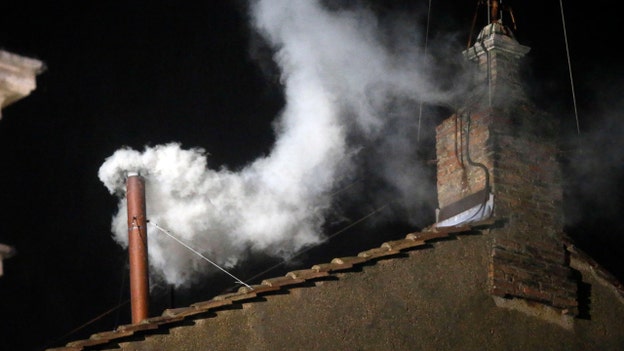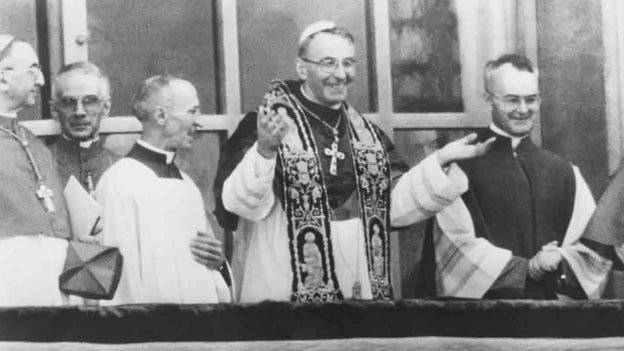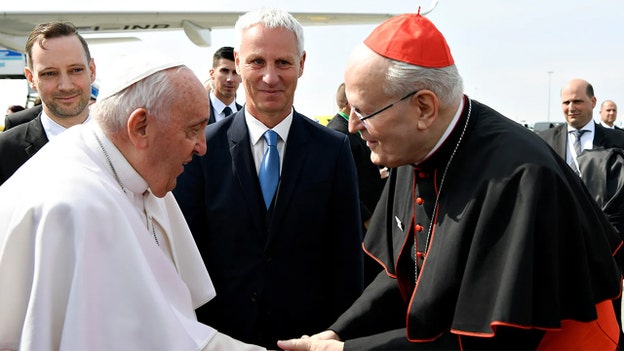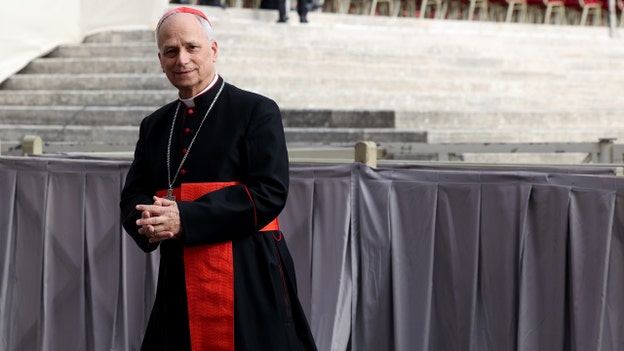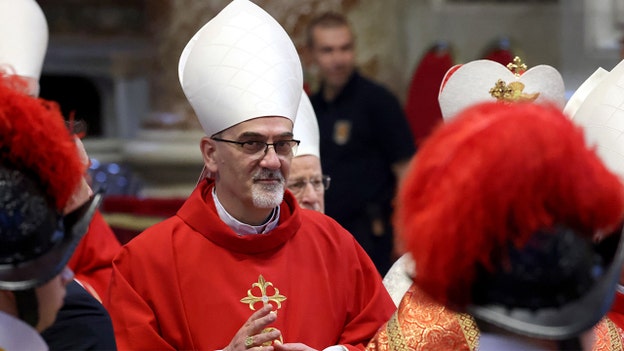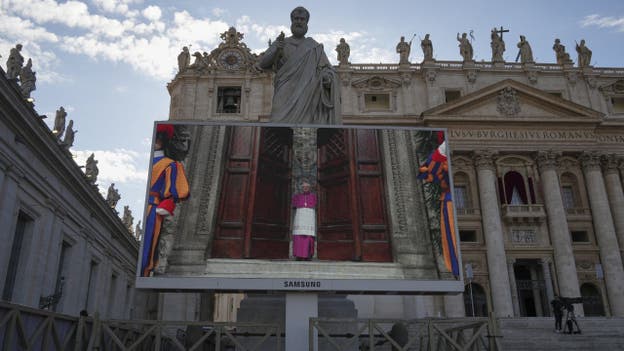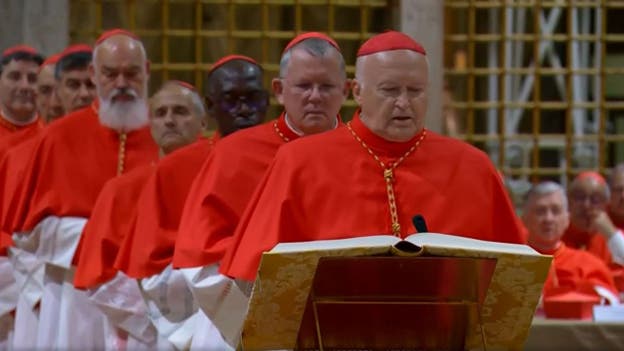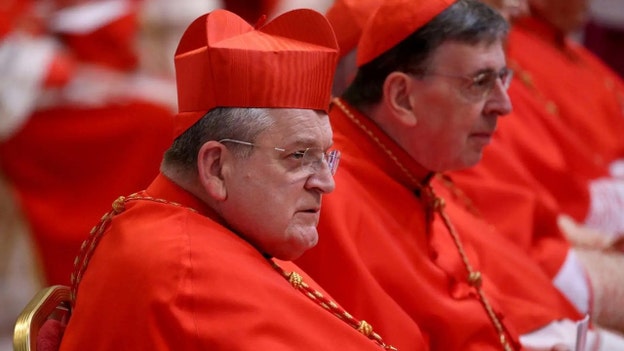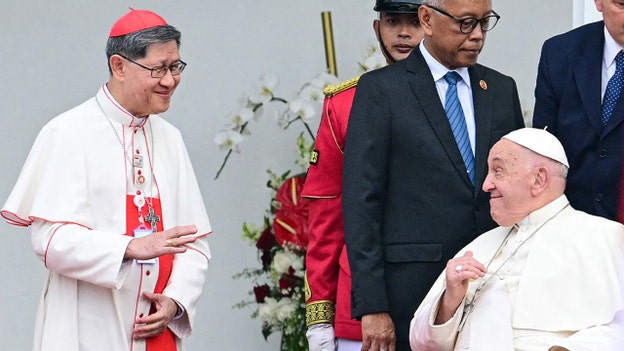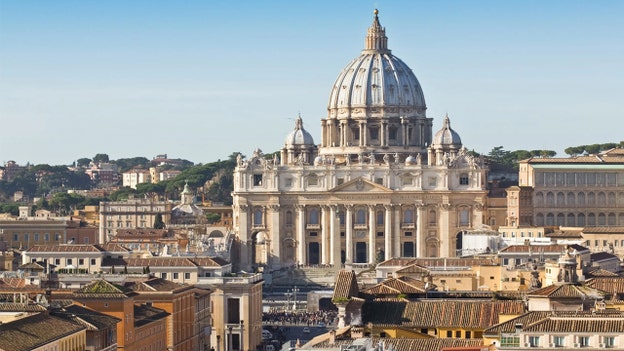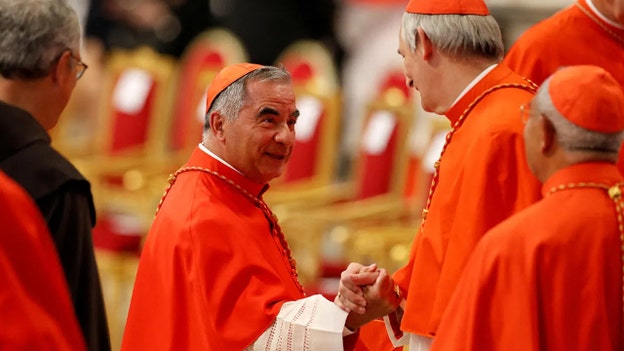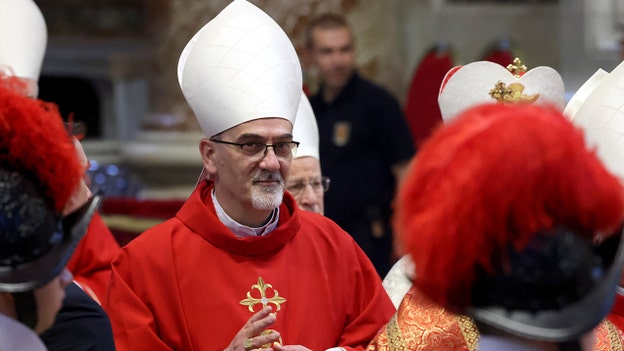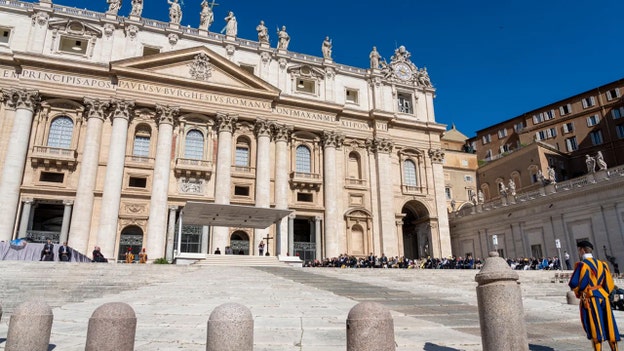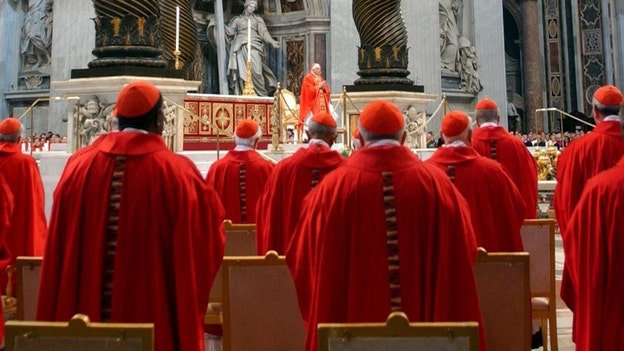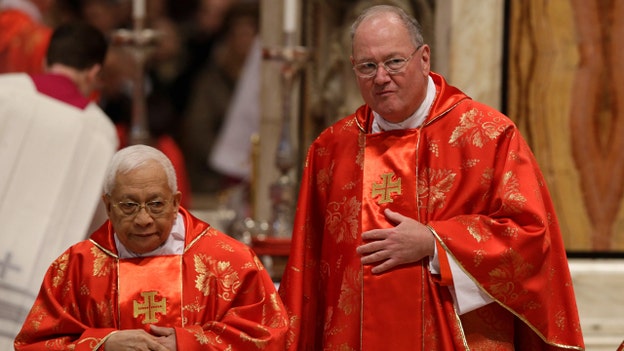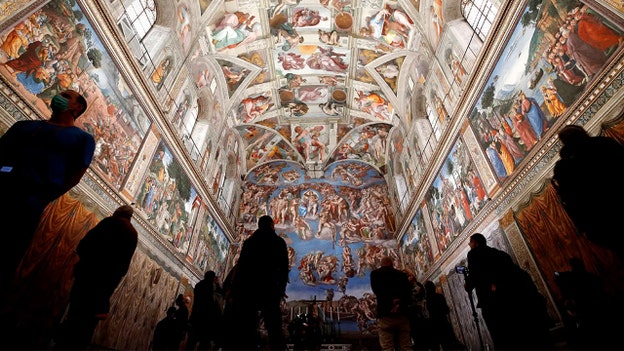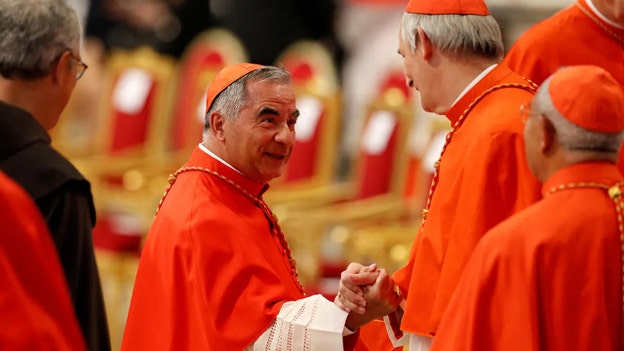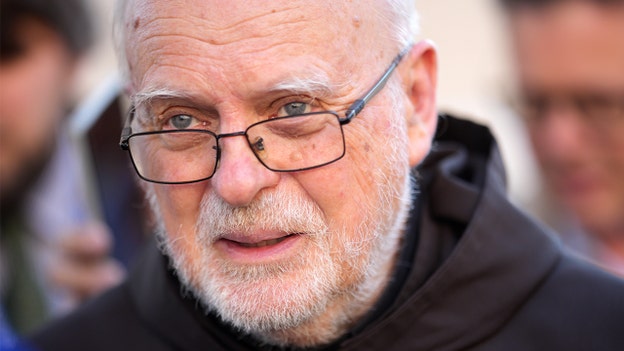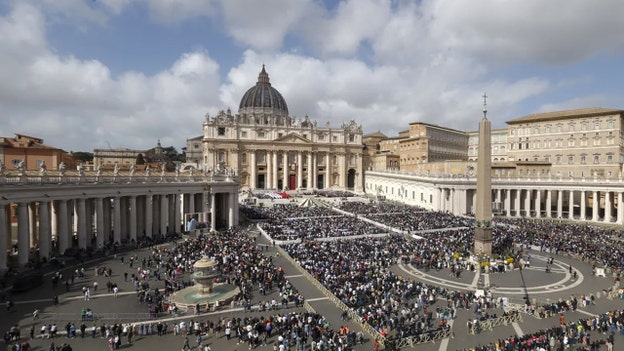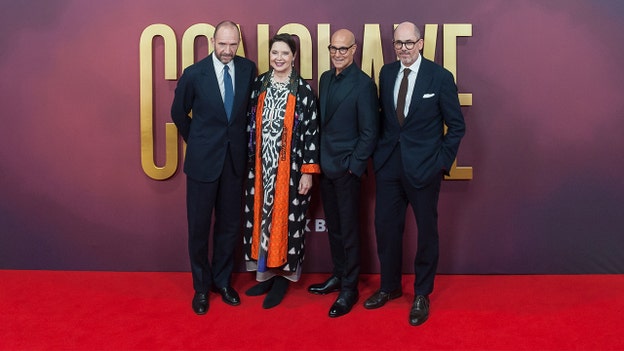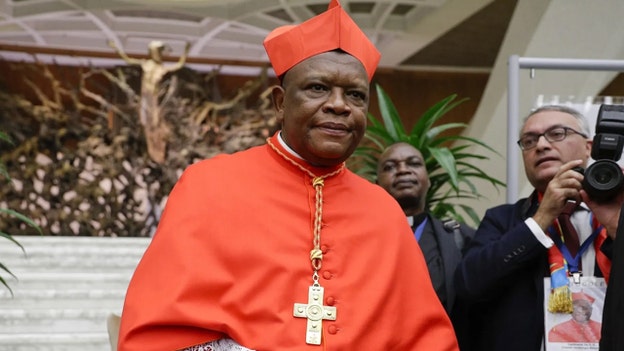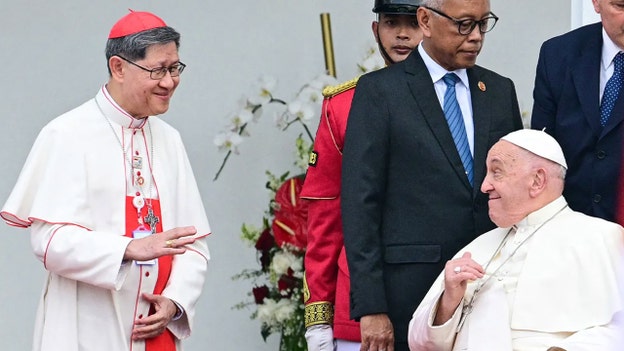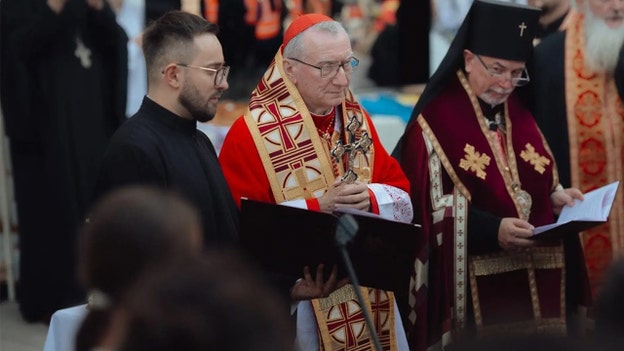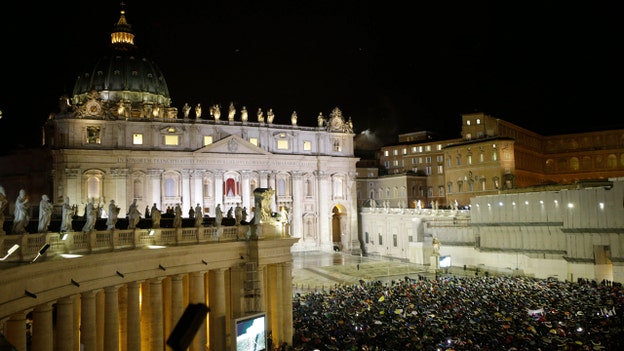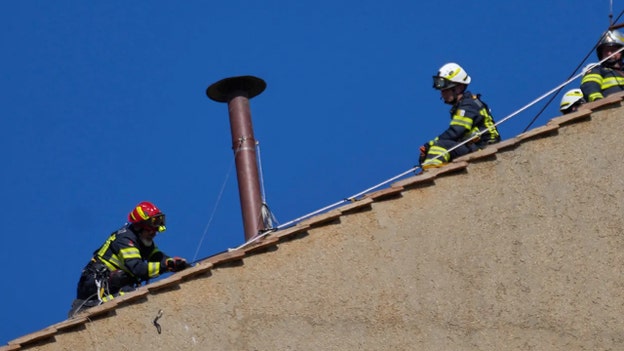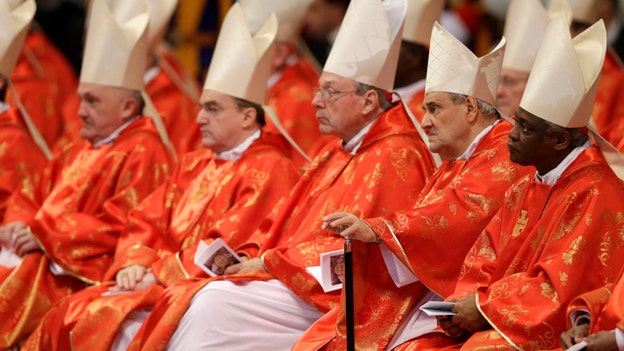Cardinal Robert Prevost announced as first American pope, taking name Leo XIV
The Vatican announced the election of Pope Leo XIV shortly after white smoke blew from the roof of the Sistine Chapel on Thursday. The pope's birth name is Robert Francis Prevost. He is the first pope from the United States of America.
Coverage for this event has ended.
The United States Conference of Catholic Bishops (USCCB) welcomed Pope Leo XIV as the leader of the Church and offered prayers of thanksgiving for his election to the post.
Archbishop Timothy P. Broglio, president of USCCB, issued a statement about Pope Leo XIV’s election on behalf of the organization.
“In communion with Catholics around the world, the bishops of the United States offer prayers of thanksgiving for the election of His Holiness Pope Leo XIV,” the statement read. “In my lifetime, the Church has been blessed with a series of popes each uniquely prepared for his particular moment in history yet sharing a common mission to proclaim the ageless truth of the Gospel.
“I rejoice in the international experience of the new Bishop of Rome who has been a student and superior in Rome, a bishop in Peru, and charged with the Dicastery for Bishops,” Broglio continued. “Certainly, we rejoice that a son of this Nation has been chosen by the cardinals, but we recognize that he now belongs to all Catholics and to all people of good will.
“His words advocating peace, unity, and missionary activity already indicate a path forward,” he added. “Trusting in the Holy Spirit, we also pray that the Holy Father, as the successor of St. Peter, will enjoy serenity in his ministry and be a watchful and wise shepherd who will confirm us in our faith and fill the world with the hope inspired by the Gospel of Jesus Christ.”
The Chicago Diocese will hold a Mass of Thanksgiving for the Election of Pope Leo XIV on Friday at 8 a.m. at the Holy Name Cathedral, which will be led by Bishop Lawrence J. Sullivan, vicar general of the Archdiocese of Chicago.
Bishop Robert Barron of the Winona-Rochester, Minnesota diocese on Thursday shared his reaction to Pope Leo XIV’s election.
Appearing on Bret Baier’s "Special Report," Barron said he was that the election happened so quickly. He said he was, like many others, initially doubtful that an American would ever get elected pope.
“We were all flabbergasted to hear it was an American. After the shock of it all wore off, you look at this figure and you say, ‘well, in many ways, he’s an obvious choice,’” Barron said. “[He’s got] an extraordinary range of administrative experience, in missionary work, in canon law, running a worldwide order of the Augustinians, and then being a prefect of the Dicastery of Bishops, which means he had contacts all over the world.”
Pope Leo XIV, who graduated from Villanova University in 1977, also received an honorary degree from Merrimack College, both of which are the only two higher education institutions established in the U.S. by the Order of St. Augustine.
After learning that its honorary alumnus had been appointed to serve as the 267th pope, Merrimack College turned to X to honor Pope Leo XIV.
“Merrimack offers its congratulations and joyful prayers to Pope Leo XIV, the first American and Augustinian pontiff,” the college posted on X. “In 2005, when he served as Prior General of the Augustinians, then Rev. Robert F. Prevost, O.S.A., visited MC, celebrated Mass and received an honorary degree.”
According to Boston 25 in Massachusetts, Pope Leo XIV was recognized in 2005 by Merrimack College for his work in Augustinian education.
Father Ray Dlugos serves as the Vice President of Mission and Ministry at the college, which is just one of two Augstinian colleges in the country.
"I was in at least two or three philosophy classes with him, and from that experience I can, and I’m going to betray my Philadelphia roots and become a New Englander, I can tell you he is wicked smart!" Dlugos told the station.
Fox News Digital’s Nick Butler contributed to this report.
Pope Leo XIV, who is a dual citizen of the U.S. and Peru, once delivered food and blankets to remote Andean villages using a white pickup truck.
Becoming the first pope to ever come from the U.S. and Peru, Pope Leo XIV, who’s birth name is Robert Prevost, served as a missionary in Peru, as well as a bishop.
Specifically, Prevost spent time in Chiclayo, which has a population of over 800,000 and plays a vital role as the main commercial hub of Peru’s northern coast. Highways link the city to the Andes mountains as well as the Amazon region.
In 2014, he served as the administrator and later bishop of Chiclayo, where he remained until Pope Francis summoned him to Rome in 2023 to serve as the powerful head of the office that vets bishop nominations around the world, the Associated Press reported.
But before moving to Rome, Prevost delivered food and blankets to remote Andean villages, driving a pickup truck and sleeping on a thin mattress on the floor.
The villages, Janinna Sesa told the AP, would offer him food and he would eat whatever, including the peasant diet of potatoes, cheese and sweet corn.
He would sometimes enjoy carne asada – one of his favorite dishes – along with a glass of Coca-Cola.
“He has no problem fixing a broken-down truck until it runs,” Sesa said.
She also said Prevost was the force behind the purchase of two oxygen-production plants during the COVID-19 pandemic, which killed over 217,000 people in Peru.
“He worked so hard to find help, that there was not only enough for one plant, but for two oxygen plants,” she said.
The Associated Press contributed to this report.
Video released by Vatican News shows the moments after Pope Leo XIV was voted in as the 267th pontiff, giving an inside look at what goes on behind the scenes.
The video began with cardinals singing a hymn with the new pope standing before them, and everyone surrounded by Michelangelo’s historic ceiling piece.
Leo XIV is then escorted past the cardinals as they clapped for the new leader of the Catholic Church.
As he walked past members of the Pontifical Swiss Guard, and each of them saluted.
By the end of the video, Leo XIV can be seen shaking hands and waving at his colleagues.
Pope Leo XIV, formerly known as Cardinal Robert F. Prevost has voted in Republican primaries more so than those for Democrats, according to reports.
The New York Times reported that according to public records obtained by the paper, the new pope voted in three republican primaries since 2012 and did not vote in Democratic primaries during the same time period.
The most recent Republican primary Pope Leo XIV participated in was the Republican primary in 2016.
The data, from Will County, Illinois, also showed the pontiff did not vote there during the 2020 presidential election or midterm election in 2022.
Illinois does not require voters to declare or register as members of a political party.
Former Vice President Mike Pence, a Republican, reacted to the pontiff’s appointment as the 267th pope on social media.
“God Bless pope Leo XIV,” Pencen wrote, adding a set of prayer hands.
He then shared a quote from Pope Leo XIV from when he served as a cardinal.
"We cannot build a just society if we discard the weakest-whether the child in the womb or the elderly in their frailty-for they are both gifts from God," the quote read.
Vice President JD Vance also reacted, saying, “Congratulations to Leo XIV, the first American Pope, on his election! I’m sure millions of American Catholics and other Christians will pray for his successful work leading the Church. May God bless him!”
Vance was one of the last visitors to see Pope Francis before the first Jesuit to lead the Catholic Church died at age 88 on April 21.
Catholic school students at St. Aloysius Academy in Bryn Mawr, Pennsylvania, erupted in celebration after learning about the appointment of Pope Leo XIV, Thursday.
The school, located down the road of the newly-minted first American pontiff, Cardinal Robert Francis Prevost's alma mater, Villanova University, posted the video on social media.
"We just told the boys who were having lunch that we have a new pope! Pure excitement," St. Aloysius Academy posted on Facebook.
Chicago Mayor Brandon Johnson called the appointment of Pope Leo XIV “one of the biggest moments” in modern history for the city.
Johnson turned to X on Thursday after former Cardinal Robert Francis Prevost was voted to serve as the 267th pope.
“The Pope is from Chicago. This is one of the biggest moments in the modern history of our city,” Johnson wrote. “Pope Leo XIV will be a champion for workers all over the world. It’s only right that he was born and educated in the most pro-worker city in America.
“The Catholic Church has a strong tradition of standing up for the poor and the vulnerable, and I know that Pope Leo XIV will continue that tradition,” he continued. “This is a tremendous moment for our Catholic community and for all Chicagoans. God bless Chicago. God bless Pope Leo XIV.”
The election of Pope Leo XIV has many wondering who the man born with the name Robert Francis Prevost, including a classmate from his alma mater Villanova University.
Brian Kerwin told Fox News that he and the new pope were part of the class of 1977 graduates at the university, though he admitted they may not have had classes together.
Kerwin said he was thrilled when he heard one of his classmates was in the running, and went out to learn everything about the former Cardinal.
“The fact that he’s half-Peruvian from Chicago, I have some Peruvians very involved in my life,” Kerwin said. “To have an American preach the Lord’s gospel is wonderful. I think he’d help bring peace to earth.”
Fox News' Jacqliene Mangini contributed to this report.
The Archdiocese of Chicago celebrated the news of the first American pope’s election in a press conference on Thursday, in which they shared some insight into what kind of leader Chicago native Leo XIV might be.
Chicago Auxiliary Bishop Lawrence Sullivan said that, “Pope Francis was certainly someone who cared for those who are living on the fringes, who could easily be forgotten. And I, strongly suspect that Pope Leo the 14th will do the same thing. He will give voice to the voiceless.”
Rev. Gregory Sakowicz, rector of Chicago’s Holy Name Cathedral, said that Leo will be influenced by his Chicago upbringing, saying, “You can never deny your roots. So, I'm sure he has a love for Chicago, love for the United States. That's part of his upbringing.”
Smiling, Sakowicz said that “one burning question I have is the fact that the Pope, Leo the 14th, or the cardinal, then Robert Prevost, was born in Chicago on the South Side. Is he a Chicago White Sox fan?”
Sakowicz said he did not know whether Leo was a White Sox fan but that he knows “he's a Cubs fan.”
“I heard he's a Cubs fan. Well, God bless him, and God bless all the fans,” said Sakowicz.
Cardinal Robert Prevost has become the Catholic Church’s new pope.
His election was announced by the Vatican on Thursday afternoon, with the newly elected pope stepping out to address those gathered in St. Peter’s Square shortly thereafter.
Prevost, the first American pope, will head up the Catholic Church as Leo XIV.
The new pope, who is 69, hails from Chicago originally.
He is a graduate of Villanova University from the class of 1977, according to the College of Cardinals Report. He obtained a mathematics degree from the school.
Find out more about Pope Leo XIV .
This is an excerpt from a story by FOX Business’ Aislinn Murphy.
Villanova University celebrated the appointment of Pope Leo XIV, a member of the Pennsylvania school’s class of 1977, calling the papal event “a moment of profound significance.”
“Today we joyously celebrate the election of His Holiness, Pope Leo XIV, a moment of profound significance for the global Church,” the university wrote in a post on X. “A Villanova alumnus, Pope Leo XIV is the first Pope from the United States and the first Augustinian friar to be elected.”
In a press release, the school acknowledged it being an Augustinian Catholic institution, adding that it is celebrating the significant day.
“Villanova, built on the teachings of St. Augustine, has always been grounded in advancing a deeper understanding of the fundamental relationship between faith and reason—between spirituality and wisdom,” University President the Rev. Peter M. Donohue said “With today’s election of His Holiness, Pope Leo XIV, I cannot help but reflect on what his Augustinian papacy will mean to our University community and our world. Known for his humility, gentle spirit, prudence and warmth, Pope Leo XIV’s leadership offers an opportunity to reaffirm our commitment to our educational mission.”
Pope Leo XIV, 69, was elected to take up the papal seat on Thursday, on the second day of the papal conclave’s deliberations.
Born Robert Prevost on Sept. 14, 1955, in Chicago, Illinois, he was a suspected front-runner to succeed Pope Francis after his passing late last month, though some reporting suggested his being an American could actually count against him due to concerns that the U.S. could further exert its geopolitical prowess through the religious leader.
Leo XIV was first brought to the Vatican by Francis to serve as prefect of the Dicastery for Bishops in January 2023, which is one of the most important positions in the Catholic Church as it vets bishop nominations issued globally.
Francis then elevated him to the position of Cardinal in September 2023.
Learn more about Pope Leo XIV’s road to becoming the new pontiff.
This is an excerpt from a story by Caitlin McFall.
A New York bishop said he is thrilled that an American was chosen to serve at the Pope, adding it will be “incredibly beneficial.”
John Bonnici, Auxiliary Bishop, NY Archdiocese spoke to Fox News on Thursday, saying the Chair of Peter is no longer vacant, now that Pope Leo XIV has been voted to serve..
“I am excited that an American has been chosen to be the Holy Father, and that now proves that all things are possible with God,” Bonnici said. “And it must tell you, too, that his background, I think, is going to be incredibly beneficial.
“You know, the cardinals chose wisely, inspired by the spirit. Here you have a man that isn't American, that is proficient in different languages,” he continued. “His Italian was flawless. He speaks Spanish. We keep talking during the coverage about the Catholic Church being in the South. He served as a bishop in Peru and, of course, you know, gave a shout out to the people that he served so beautifully for a long time.
Bonnici also spoke about Pope Leo XIV’s experience as an Augustonian priest, a missionary in various roles, a pastoral leader and the role he plate din his administration.
“So he comes to this…with a wealth of experience, and I do honestly believe that he's going to be able to apply all that in a very special way to his new mission as Holy Father,” he added.
The vast majority of Popes have been Italian but the last four pontiffs have all hailed from non-Italian countries, not that Pope Leo XIV of the United States has been elected.
Of the 266 Popes to lead the Catholic Church, 217, or 81% of them were Italian with Italy’s dominance in the papacy reflecting the Vatican's location in Rome, Italy, and the historic influence of the Italian clergy in the Church.
Despite Italy’s papal preeminence, there hasn’t been an Italian Pope since Pope John Paul I served for 33 days in 1978.
He was succeeded by Pope John Paul II (1978–2005) from Poland, who was followed by Pope Benedict XVI (2005–2013) from Germany and then Pope Francis (2013–2025) from Argentina, who was the first from the Americas.
Pope Leo XIV, elevated on Thursday, is 69 years old. His full name is Robert Francis Prevost and he is from Chicago, Illinois.
For 455 years between the death of Dutchman Adrian VI in 1523 and the election of John Paul II in 1978, the Italians had total control of the papacy.
Saint Peter, one of the twelve apostles of Jesus, is considered the first Pope and he was from Bethsaida in Galilee, which is in present-day northern Israel.
World leaders hailed the election of Pope Leo XIV on Thursday.
President Donald Trump remarked on the honor for the U.S., with Leo being the first American pope.
French President Emmanuel Macron said he extended a "message of fraternity" to Leo and Catholics across the globe.
"May this new pontificate be one of peace and hope," he wrote.
British Prime Minister Keir Starmer also hailed the "deeply profound moment" of Leo's election, adding that he hopes to meet with the Holy Father soon.
"Pope Leo is the first American Pope. This is a momentous moment," Starmer wrote.
"I look forward to meeting the Holy Father and continuing to work closely with the Catholic Church here in the U.K. and internationally to advance our shared values and the common good," he added.
Italian Prime Minister Giorgia Meloni also marked Leo's election.
"I extend my most sincere wishes to Pope Leo XIV for the beginning of his pontificate. In a time marked by conflict and unrest, his words from the Loggia delle Benedizioni are a powerful call for peace, brotherhood and responsibility," she wrote in Italian.
"A spiritual legacy that follows the path traced by Pope Francis, and that Italy looks at with respect and hope," she added.
Bishop Robert Barron said he was shocked at the election of Pope Leo XIV, the first American pope in history on Thursday.
Barron said he thought no American would be elected pope "until we go into more of a cultural and political decline."
He said he was skeptical that cardinals from elsewhere in the world would "want to give America control over the church."
Born in Chicago, Illinois, the new pope's given name is Robert Francis Prevost.
President Donald Trump called the election of Pope Leo XIV a "great honor for our country" on Thursday, just minutes after the Vatican elevated the first American pope.
Born Robert Francis Prevost, the new holy father is from Chicago, Illinois. Trump congratulated the pope and said he looks forward to meeting with him for the first time.
"Congratulations to Cardinal Robert Francis Prevost, who was just named Pope. It is such an honor to realize that he is the first American Pope. What excitement, and what a Great Honor for our Country. I look forward to meeting Pope Leo XIV. It will be a very meaningful moment!" Trump wrote.
Pope Leo XIV called on Catholics to live as missionaries during his first address since his election on Thursday.
The pope stressed that he hopes to be a builder of peace during his papacy.
He asked Catholics to assist him in bringing peace to "all peoples," and participating in dialogue and "building bridges."
The College of Cardinals deliberated for nearly 24 hours before two thirds of them decided on the new holy father.
The Vatican announced the election of Pope Leo XIV shortly after white smoke blew from the roof of the Sistine Chapel on Thursday.
Cardinal Protodeacon Dominique Mamberti announced the pope's election in St. Peter's Square.
The 133 voting cardinals deliberated in the Sistine Chapel for roughly 24 hours as thousands of faithful waited in Vatican City.
The pope's birth name is Robert Francis Prevost. He is the first pope from the United States of America.
"Annuntio vobis gaudium magnum: habemus Papam!" or, "I announce a great joy: we have the Pope!" Mamberti announced as tens of thousands cheered.
The term "habemus papam" is expected to be ring out across St. Peter's Square when the new pope is announced on Thursday, following the white smoke that emerged over the Sistine Chapel.
The term is a Latin phrase used to announce the election of a new pontiff and means "We have a pope," according to the Catholic News Agency.
It is part of a longer phrase that will likely be announced by the Dominique Mamberti, the Cardinal Protodeacon, who will reportedly say, “I announce to you a great joy: We have a pope! The Most Eminent and Most Reverend Lord, Don [given name], cardinal of the Holy Roman Church [surname], who has imposed on himself the name of [papal name].”
All of Rome is descending on St. Peter's Square in anticipation of the announcement of the new pope on Thursday.
White smoke blew from the roof of the Sistine Chapel after cardinals deliberated for nearly 24 hours.
A two-thirds majority of the 133 voting cardinals was required to select a new pope.
"Annuntio vobis gaudium magnum: habemus Papam!" or, "I announce a great joy: we have the Pope!" will be the declaration.
Once the new pope accepts his nomination and has chosen his papal name , he will enter the “Room of Tears” ( “Stanza della Licrime.) According to the Catholic News Agency, the room is known by this since it’s the first place the new Pope will go to face the reality of his new position. Pope Leo XIII reportedly wept upon entering the room in 1878.
According to the Associated Press the room is named for the emotional weight of responsibility ahead for the new pontiff. Known in Italian as “Stanza della Licrime,” it’s just a few feet away from the Sistine Chapel.
It’s in this room where the Pope will change from his red cardinal vestments to his new, white papal ones. There are various sizes available to accommodate whoever the pope may be.
In this room, the newly elected pope will have a short amount of time to reflect on his decision to accept his new role, and position before he gets introduced to the world, and greet the thousands waiting in St. Peter’s Square and millions watching from around the globe.
Jacqliene Mangini and Fox News Digital’s Nick Butler contributed to this report.
White smoke rose from the chimney above the Sistine Chapel, indicating that cardinals have successfully elected a new pope.
The identity of the pope has yet to be revealed.
The 133 voting cardinals deliberated in the Sistine Chapel since Wednesday, the first day of the conclave.
Pope John Paul I, born Albino Luciani, was elected as pope of the Catholic Church on Aug. 26, 1978. His reign as the sovereign of Vatican City was brief, as he died 33 days later.
He was ordained in 1935, appointed bishop in 1958 and created archbishop of Venice in 1969. He is often referred to as "the Smiling Pope."
Pope John Paul II, who was elected pope after the death of Pope John Paul I, named himself in honor of the late pope.
Who is the dean of the College of Cardinals?
The current dean is Italian Cardinal Giovanni Battista Re. He is the head of the College of Cardinals who informs the rest of the cardinals and the ambassadors to the Holy See of the pope’s death once he learns of it from the camerlengo. He convenes the conclave and presides as the electors take their oaths. Since Re is 91, he cannot vote, so he will leave the Sistine Chapel once the conclave begins and the most senior cardinal, Cardinal Pietro Parolin, takes over.
What is the Domus Santa Marta?
This Vatican guesthouse, built in 1996, specifically houses cardinals during a conclave and is used at other times as a hotel for visiting priests and Vatican officials. Pope Francis never moved out after he was elected, choosing to live in suite 201 rather than the papal apartments in the Apostolic Palace. Because there are so many electors this time and not enough room in the main building, some are being housed in an adjacent residence.
What does ‘extra omnes’ mean?
A Latin phrase for “all out,” it's spoken by the master for papal liturgical celebrations, currently Italian Archbishop Diego Ravelli, to ask all those present except the cardinal electors to leave the Sistine Chapel to begin the voting process during the conclave.
What does it mean when they say, ‘Habemus Papam’?
This Latin phrase translates to “We have a pope.” These are the words used by the “protodeacon” of the College of Cardinals to announce from the gallery of St. Peter’s Basilica that a new pope has been elected. He then says the new pope's birth name and the name he has chosen to use as pope, also in Latin. The current protodeacon is French Cardinal Dominique Mamberti.
Who are the infirmarii?
These are the three cardinals, chosen by a random drawing from the electors, who are charged with gathering the ballots of any electors who made it to Rome but are ill during the conclave.
Who are the revisers?
These are the three cardinals, chosen by a random drawing from the electors, who are charged with reviewing the ballots during the conclave.
Who are the scrutineers?
These are the three cardinals, chosen by a random drawing from the electors, who are charged with reviewing each ballot and announcing it to the assembled conclave after each round of voting. They then tally the votes — to win the election, two-thirds of the votes are necessary — and they burn the ballots.
What does the saying ‘sede vacante’ mean?
This is Latin for “vacant seat,” the period between the pope’s death or resignation and the election of a new one.
What does the text ‘Universi Dominici Gregis’ contain?
This Latin phrase means “the Lord’s whole flock.” It’s the Vatican constitution that regulates the processes from a pope’s death until a new one is elected. St. John Paul II issued it in 1996 during his papacy, and Pope Benedict XVI twice amended it, most significantly by removing John Paul's provision that after about 12 days of balloting a simple majority could elect a new pope rather than a two-thirds majority. If the conclave lasts that long, the top two vote-getters go to a runoff, with a two-thirds majority required to win. Neither of the top two candidates casts a ballot in the runoff.
The Associated Press contributed to this report
As the Catholic Church formally began the process of selecting the next pope this week, everyday Catholics gave insight into what they think the next leader should bring to the Vatican.
Fox News Digital took to the campus of The Catholic University of America (CUA) in the nation's capital to get a pulse on people's papal preferences ahead of the conclave, which began Wednesday.
"I'm excited for a pope that's going to unite the church, and I think that's what Francis did really well… I hope the legacy of the next pope will also be similar to that," one CUA student named Daniel told the outlet.
One Catholic student named John predicted a shift to a more pastoral nature.
"I would say, given the composition of the College of Cardinals, it would lean more, I guess, pastoral, as you would say. But you never know. There's always surprises with the conclave."
This is an excerpt from an article by Fox News Digital’s Agustin Hays, Gabriel Hays and Alba Cuebas-Fantauzzi.
Portuguese Cardinal José Tolentino Calaça de Mendonça, often referred to as one of his baptismal names Tolentino, was made prefect of the Vatican’s Dicastery for Culture and Education in 2022.Tolentino is among the youngest of the men flagged as a potential successor to Pope Francis, which could hinder his chances of landing the papal seat. He was also closely aligned with Francis on several issues which has garnered some controversy, particularly when it comes to the church’s position on same-sex relationships.
The Portuguese cardinal is also viewed as liberal leaning given his push for the church to engage with modern culture, including in his support of a feminist Benedictine sister who favors women’s ordination and is pro-choice.
This is an excerpt from an article written by Fox News' Caitlin McFall
The leader of the Roman Catholic Church does not get paid what many consider a traditional salary. Instead, the Vatican provides for the pontiff's needs, from housing, food, transportation and other expenses in the form of stipends and allowances.
The Vatican, referred to as "the world's smallest country," is sustained by "an economy that relies on a combination of donations, private enterprises, and investments to generate revenue," according to Investopedia.
Pope Francis declined any sort of salary when he took office in 2013, The Economic Times reported back in February, adding that the pontiff at the time had a net worth of "around $16 million, which includes various assets provided to him as the pope."
The Vatican's financial situation has been in peril for years, with its annual operating deficit growing to over $90 million in 2023, according to reports. In November, Pope Francis warned that the Vatican's pension fund — which provides pensions to employees of the Holy See and Vatican City State — has been facing a "severe prospective imbalance" that "tends to grow over time in the absence of interventions," according to the Vatican News.
The governing body of the Vatican, also known as the Holy See, doesn't provide exact numbers regarding its finances. However, the Central Intelligence Agency’s World Factbook estimated its revenues and expenditures in 2013 notched $315 million and $348 million, respectively.
It generates this money through various avenues. According to the Michigan Journal of Economics, the Holy See generates some of its revenue through Peter’s Pence, which is a term that describes donations collected from Catholics around the world and given to the Pope on an annual basis. This accounts for $27 million each year, with the largest contributions deriving from the United States, Germany and Italy, according to American Magazine.
Fox News Digital reached out to the Vatican and United States Conference of Catholic Bishops for more information about how the pope gets paid, but did not immediately hear back.
This is an excerpt from an article by Fox News' Pilar Arias and Daniella Genovese
The first clue of the next pope's direction will be the name he chooses.
Popes used their given names for most of the Catholic Church’s first millennium. But in the mid-20th century, new popes began to choose names signaling the aim of their papacy.
The first pope to take on a different name was the 6th century Roman Mercurius, who had been named for a pagan god and chose the more appropriate name of John II.
The practice of adopting a new name became ingrained during the 11th century, a period of German popes who chose names of early church bishops out of “a desire to signify continuity," said the Rev. Roberto Regoli, a historian at Rome's Pontifical Gregorian University.
For many centuries, new popes tended to choose the name of the pope who had elevated them to cardinal. John was the most popular, chosen by 23 popes, followed by Benedict and Gregory, each with 16.
Only starting in the mid-20th century did new popes begin to choose names signaling the aim of their papacy, Regoli said.
“Even now, as we are waiting for the new pope, the name with which he will present himself will help us to understand the horizon towards which he wants to proceed," Regoli said.
Some names have been out of use for centuries, like Urban or Innocent.
“I don’t think anyone will pick Innocent,″ Imperatori-Lee said, given the abuse and other scandals that have rocked the church. ”I don’t think that would be the right choice."
Imperatori-Lee suggested another name that might signal a continuation of Francis' legacy: Ignatius, for the founder of Francis' Jesuit order.
“It would be interesting," she said. "We've never had one of those."
The Associated Press contributed to this report
Cardinal Protodeacon Dominique Mamberti will have the honor of announcing the new pope once the 133 voting cardinals make their decision in the conclave.
Unless, that is, Mamberti himself is made pope. In that case, the announcement would be made by the next most senior cardinal deacon.
"Annuntio vobis gaudium magnum: habemus Papam!" or, "I announce a great joy: we have the Pope!" will be the phrase.
Mamberti has long been a leading figure in Vatican diplomacy, and his name has also risen in recent days as a potential consensus candidate to be a successor to Pope Francis.
Mamberti has served as Protodeacon since October 2024.
Cardinal Matteo Zuppi was born in Rome. He is the president of the Italian Episcopal Conference and is viewed as an insider in Francis’ Vatican, having served as the archbishop of Bologna.
The 69-year-old Zuppi is seen as being one of Pope Francis' favorites. He was sent on a peace mission in 2023 to Ukraine, where he met with President Volodymyr Zelenskyy.
He was also sent to meet with President Joe Biden that same year. Zuppi was made a cardinal by Pope Francis in 2019.
This is an excerpt from an article written by Fox News' Caitlin McFall
In preparation for the film, Dennis Doyle, professor emeritus at the University of Dayton in Ohio, told Fox News Digital he read the book twice.
"In the book, the character was transgender but didn’t go through with the operation," Doyle said. "In the movie, the character was intersex, somebody who was born both ways, but still who didn't go through with the operation."
Doyle taught at the Catholic research university for 40 years.
Some Catholics took to social media at the time the film was released to regard it as "anti-Catholic" and "dishonest".
"I thought that everything in the movie was very realistic until the very end," Doyle said. "I thought that, on a literal level, it really wasn't very realistic. I don't think that would happen, that somebody that was intersex would get elected pope. But symbolically, I thought the ending was very interesting."
"I could see that the ending could be a turnoff for some Catholics," he added.
Doyle said that, while "kind of far-fetched," the film spoke to the question of the role of women in the church and whether men and women can become equal in the Catholic Church.
"In the film, all of the people serving the cardinals are sisters," Doyle said. "They're all nuns and in real life, in that building, there's simply a staff that works in that building, and they would be the people who would put out the meals and who would change the beds and that kind of thing."
This is an excerpt from an article written by Fox News' Gabriele Regalbuto.
After two ballots failed to elect a pope, the 133 cardinals broke for lunch ahead of at least one further round of conclave voting in the afternoon.
The cardinals are secluded from the outside world in order to ensure the integrity of the vote is not compromised, and so they take their meals at a Vatican guesthouse. And while the Sistine Chapel is known for its elegance, the meals the cardinals are being served are considered very simple Italian fare like pastas, soups, arrosticini (lamb skewers) and boiled vegetables, according to the BBC.
“Food you could eat at a train station” was how Cardinal Mauro Piacenza, a conclave veteran from the Italian city of Genoa, described the standard of food to the New York Times. “Not exciting.”
The meals are prepared by religious sisters and designed to be straightforward to help the conclave concentrate. Items like stuffed ravioli and roast chicken are prohibited since they may posed security concerns as they could potentially conceal messages intended to breach the conclave's strict confidentiality.
Pope John Paul II, born Karol Wojtyła, was elected pope of the Catholic Church on Oct. 16, 1978. He was the first Polish pontiff.
Wojtyła took the regnal name after his predecessor, Pope John Paul I, who passed away only a month into his reign as the sovereign of Vatican City.
Wojtyła's election by the College of Cardinals marked the first time a non-Italian would serve as pope in over 400 years. At 58 years old, Wojtyła was one of the youngest popes in history.
Wojtyla studied theology in Rome and served as the archbishop of Krakow. Through his 26-year pontificate, John Paul II traveled to 129 countries, becoming the most traveled pope in history.
During his papacy, John Paul II preached service, the responsibility for peace and the protection of life. In 1981, a lone gunman, Mehmet Ali Ağca, attempted to assassinate the pope in St. Peter's Square in Vatican City. He was struck twice while riding in an open car and seriously wounded. He was rushed to Gemelli Hospital in Rome and treated for his injuries.
John Paul II later visited Ağca in prison and forgave the shooter in person.
In 2005, John Paul died in his apartment in the Vatican at 84 years old.
He was canonized as a saint in 2014.
This is an excerpt from an article written by Fox News' Gabriele Regalbuto.
The College of Cardinals will elect the next pope following the death of Pope Francis on April 21, 2025.
The holy body is made up of 252 members, but only 133 of those members can participate in the vote as they have to be younger than 80 years old on the day of the pope’s passing in order to cast a ballot as of the day of a pope's death may cast a ballot.
The College of Cardinals is composed of men that the pope has elevated to the level of Cardinal, and who serve as his body of advisors, though some will prove to be closer to the pope in power than others.
The position of Cardinal is the highest in the Catholic Church under the pope and has reportedly been in existence since the early 300s.
Cardinals are said to be the “princes of the Church” and are addressed as "Eminence,” according to the Catholic News Agency.
During a conclave, cardinals vote through a secret ballot. A two-thirds majority is required for the election. After each round of submissions, ballots are read aloud and then burned. The ashes are used to notify audiences around the world and onlookers in St. Peter’s Square of the election’s status.
Black smoke from the Sistine Chapel at the Vatican indicates a new round of voting is set to happen. White smoke signals a new leader of the Roman Catholic Church is selected.
The secret process, which takes as long as needed, is vastly different from U.S. presidential, local and even mayoral elections. However, the unique election process doesn’t prevent people from drawing comparisons between the most "papabile" cardinals and U.S. political parties–Republican and Democrat.
"It's very tempting to map folks into our political categories," Gabrielli said. "Those just don't work very well in the Church. There are different emphases and priorities."
"This is a very, very different process," he added.
This is an excerpt from an article written by Fox News' Gabriele Regalbuto.
Cardinal Giovanni Battista Re, the dean of the College of Cardinals, said he hopes that a new pope would be elected by this evening.
The cardinal spoke after no new pope was elected on the second and third ballot Thursday morning with the conclave scheduled to resume voting this afternoon.
“I hope that when I return to Rome this evening, I’ll find the white smoke already rising,” Re said in the city of Pompei, according to the Associated Press citing Italian newspapers.
Re is 91 years old, which makes him too old to participate in the conclave of 133 cardinals who are electing the next pope and who all have to be younger than 80.
There are currently 252 cardinals in the College of Cardinals. More than 100 are inelgible to vote given their age.
Black smoke billowed out from the chimney of the Sistine Chapel Thursday morning indicating that no new pope was elected on the second and third ballot.
The 133 cardinals voted twice Thursday morning meaning they will be able to vote two more times this afternoon and if no new pope is elected, they will then retire until Friday.
The cardinals will return to the Sistine Chapel at 9:45 a.m. EST Thursday for the first afternoon vote, which will be the fourth ballot.
At around 11:45 a.m. EST, if someone is elected, they will burn ballots and add chemicals to make white smoke.
If no one gets a two-thirds majority, they save the ballots and vote again at around 1 p.m. EST for a fifth time.
Pope Francis was elected in 2013 on the fifth ballot, while Pope Benedict XVI won in 2005 on the fourth ballot, and Pope Pius XII, elected in 1939 won on the third ballot
Black smoke was seen emanating from the chimney of the Sistine Chapel Thursday morning signaling that no new pope has been elected.
The smoke came after two rounds of voting among the Catholic Cardinals on Day 2.
Each time the College of Cardinals votes on a new pope but does not elect one, the end of a voting round is signified with black smoke from the Sistine Chapel's chimney.
The Cardinals will be able to vote two more times Thursday before retiring until tomorrow.
To become a pope, a cardinal needs a two-thirds majority, or 89 of the 133 votes. This conclave is the most geographically diverse conclave in the faith’s 2,000-year history.
Catholic pilgrims, school children, tourists and priests gathered in St. Peters Square Thursday morning watching to see if white smoke will pour out from the chimney of the Sistine Chapel — signifying that a new pope has been chosen.
All eyes are on the chimney as Catholic Cardinals carefully deliberate inside for the second day of voting to elect a new pope.
A group of faithful from France chanted religious songs as they arrived at the square as anticipation builds.
Seagulls perched on the roof nearby as the crowds in the piazza below waited in suspense. Entire school groups joined the mix, blending in with people participating in preplanned Holy Year pilgrimages.
More than 130 cardinals are expected to vote again Thursday after spending the night sequestered at the Vatican residences.
The Associated Press contributed to this report
Catholic Cardinals on Thursday returned to the Sistine Chapel in the Vatican City to begin a second day of voting to elect a new pope.
More than 130 cardinals are expected to vote again in the morning after spending the night sequestered at the Vatican residences.
Black smoke poured out of the Sistine Chapel chimney Wednesday evening, signaling that no pope was elected on the first ballot of the conclave.
The cardinals have been sworn to secrecy in the centuries-old ritual to elect a new leader of the 1.4 billion-member Catholic Church.
To become a pope, a cardinal needs a two-thirds majority, or 89 of the 133 votes. This conclave is the most geographically diverse conclave in the faith’s 2000-year history.
The Associated Press contributed to this report.
After a cardinal receives the necessary two-thirds majority vote to be elected pope, the dean of the College of Cardinals, Italian Cardinal Giovanni Battista Re, will ask the elected candidate: “Do you accept your canonical election as Supreme Pontiff?”
If the elected cardinal accepts, he then chooses his new name, and from this point forward, he assumes full authority and responsibility for the Catholic Church. The cardinals present give their respects to the new pope, and the votes are burned to send a signal of white smoke from the Vatican’s Sistine Chapel to the entire world.
Shortly after this, the cardinal proto-deacon, currently French Cardinal Dominique Mamberti, proclaims the famous Latin words: “Annuntio vobis gaudium magnum; Habemus Papam,” that is “I announce to you with great joy: We have a pope!”
After this, the new pope imparts his apostolic “Urbi et Orbi” (“to the city (Rome) and world”) blessing from St. Peter’s Basilica.
133 Cardinals from 71 different countries across the globe are in Vatican City for the Conclave, which began on Wednesday, to elect the new Pope. The conclave is taking place in the Sistine Chapel, which is now closed to the public.
Pope Francis was instrumental in making the College of Cardinals less eurocentric by expanding it to include more cardinals from other continents.
53 Cardinals from Europe, 37 from the Americas, 23 from Asia, 18 from Africa, and four from Oceania are present at the Conclave. Cardinal and Archbishop of New York Timothy Dolan is also in attendance as one of 10 Cardinals from the United States.
For the first time, 15 nations are represented by native Cardinal Electors hailing from Haiti, Singapore, Serbia, Papua New Guinea, Cape Verde, the Central African Republic, Myanmar, Rwanda, Tonga, Malaysia, Sweden, Luxembourg, Timor Leste, Paraguay, and South Sudan. The age range of the Cardinals spans generations, from the youngest being 45, Mikola Bychok of Ukraine and the oldest being 79, Carlos Osoro Sierra from Spain.
The conclave has gathered again in actuality as the Vatican revealed that Pope Francis, 88, the leader of the Catholic Church, passed on April 21, 2025, the day after Easter Sunday.
Though released in October 2024, "Conclave" struck a deep chord with viewers as Pope Francis’ declining health was made known to the public in February 2025.
The film closely follows the novel of the same name written by author Robert Harris.
"That was fairly accurate," Dennis Doyle, professor emeritus at the University of Dayton in Ohio, told Fox News Digital.
Doyle taught at the Catholic research university for 40 years.
"There were just a few differences, like some of the Latin wasn't exact, the carpet was red in the movie and its beige in real life," Doyle said. "The seating arrangements were done very dramatically in the movie. They're not exactly that way in real life. And even the way the voting was done was not exactly the same."
Despite the creative liberties, Doyle felt the film was "done very accurately."
"I was surprised at how well it was done and how they were able to present the characters in a way that every character in a certain sense was sympathetic," Doyle told Fox News Digital.
This is an excerpt from an article written by Fox News' Gabriele Regalbuto.
UK-based betting platform Kalshi, which describes itself as "the first CFTC regulated exchange dedicated to trading on the outcome of future events," is offering favorable odds to Cardinal Pietro Parolin according to an X post by PopCrave.
At the time of posting, Cardinal Parolin had over 30% support to take the Papacy, more than any other cardinal on the platform. He holds 27% support on the platform at the time of writing this post.
Parolin is seen by many as a compromise candidate between progressives and conservatives in the Catholic Church, and a diplomat.
The X post has accumulated nearly 300k views and 4k likes.
Kalshi did not immediately respond to Fox News Digital's request for comment.
Cardinals from around the world are participating in the papal conclave at the Sistine Chapel, and in the “Room of Tears” are various sizes of dress to ensure a proper fit on the new pope.
After two weeks since the death of 88-year-old Pope Francis, 133 cardinals entered into the Sistine Chapel on Wednesday to begin the selection process.
The voting, which occurs behind closed doors, will continue until a new leader of the Catholic Church is elected.
Only after receiving a two-thirds majority vote will the new pope enter into the “Room of Tears” where he will find his new attire in different sizes in the Vatican City.
What is the 'Room of Tears?'
Once the new pope accepts his nomination and has chosen his papal name , he will enter the “Room of Tears” ( “Stanza della Licrime.) According to the Catholic News Agency, the room is known by this since it’s the first place the new Pope will go to face the reality of his new position. Pope Leo XIII reportedly wept upon entering the room in 1878.
According to the Associated Press the room is named for the emotional weight of responsibility ahead for the new pontiff. Known in Italian as “Stanza della Licrime,” it’s just a few feet away from the Sistine Chapel.
It’s in this room where the Pope will change from his red cardinal vestments to his new, white papal ones. There are various sizes available to accommodate whoever the pope may be.
In this room, the newly elected pope will have a short amount of time to reflect on his decision to accept his new role, and position before he gets introduced to the world, and greet the thousands waiting in St. Peter’s Square and millions watching from around the globe.
Jacqliene Mangini and Fox News Digital’s Nick Butler contributed to this report.
While cardinals continue to determine who will lead the Catholic Church into the coming years, Cardinal Timothy Dolan of New York City could be in contention as the next pontiff.
Fox News contributor Jonathan Morris said in a post on X Dolan is originally from St. Louis, served as a diocesan priest, went on to become an archbishop in Milwaukee, Wisconsin and ultimately landed in New York City, where today he serves as a cardinal.
Dolan, at the age of 75, may sound like he is on the older side of becoming a pope, but the last two pontiffs were 78 and 76 when they were elected to serve, Morris continued to explain, and both had “relatively long pontificates.”
Pope Benedict was elected to the papacy in April 2005 and stepped down in February 2013 at the age of 85. He died in 2022.
Morris’ guess is that the cardinals do not want to elect a very young pope, admitting that was just his own take.
So when it comes to Dolan, he continued, the cardinal is a great communicator of faith who talks about Jesus in a way Catholics and non-Catholic Christians can understand and get behind.
Morris said that while Dolan may not have many votes at the beginning, the goal is to get a two-thirds majority. The candidate may not get the first vote, but eventually, Morris added, people will say that the cardinal is someone they can get behind, even if he was not their first vote.
Once a new pope is voted in, the name he chooses could signal the direction the Catholic Church moves in the coming years.
The announcement "Habemus Papa," or, "We have a pope," will be made from the balcony of St. Peter’s Basilica. It will then be followed by the pontiff’s baptismal name in Latin, along with his chosen papal name and meaning.
Should the pope choose to go with Pope Francis II , it could signify continuity with the late pontiff’s pastoral legacy, though Francis himself quipped that whoever succeeds him would be John XXIV, named after the Vatican II-era pope.
Find out more about the importance of a pope’s chose name.
The 2013 election of Argentinian Cardinal Jorge Bergoglio, who would go on to choose the regnal name of Francis, surprised many, Catholics included. Pope Francis was selected just 24 hours into the conclave and five ballots in. Shortly after his election was announced, Dr. Gilberto Cavazos-Gonzalez, then visiting professor at the Pontifical University Antonianum in Rome, reacted that the decision was “so out of left field” but that he was “tearing up” with joy over that a Latino had been selected to lead the church.
Francis came as a surprise to many for several reasons, including that it was the first time in history that either a South American or a Jesuit had been elected pope. What’s more, Francis’ name was not consistently featured on the shortlists of possible candidates.
Many expected Francis’ successor would share the conservative, more traditional vision of Pope Benedict XVI, Francis’ predecessor.
Shortly before Francis’ election, American author and theologian R.R. Reno told Fox News Digital that because “the entire College of Cardinals has been appointed by Pope John Paul II and Benedict XVI” it was “extraordinarily unlikely that the next pope will not reflect their collective interpretation of the council, which means in worldly terms, a conservative pope.”
The tens of thousands of spectators waiting in Vatican City for a new pope to be elected learned late Wednesday that the vote will continue, after black smoke billowed from the chimney installed on the roof of the Sistine Chapel.
One hundred thirty-three Cardinals from 71 different countries across the globe gathered in Vatican City to begin the Conclave to elect the new Pope. The process began on May 7, 2025 at the Sistine Chapel, which is now closed to the public.
Former Pope Francis was instrumental in making the College of Cardinals less eurocentric by expanding it to include more cardinals from other continents.
Fifty-three Cardinals from Europe, 37 from the Americas, 23 from Asia, 18 from Africa, and four from Oceania will be present at the Conclave. Cardinal and Archbishop of New York Timothy Dolan will be in attendance as one of 10 Cardinals from the United States.
For the first time, 15 nations will be represented by native Cardinal Electors hailing from Haiti, Singapore, Serbia, Papua New Guinea, Cape Verde, the Central African Republic, Myanmar, Rwanda, Tonga, Malaysia, Sweden, Luxembourg, Timor Leste, Paraguay, and South Sudan. The age range of the Cardinals spans generations, from the youngest being 45, Mikola Bychok of Ukraine and the oldest being 79, Carlos Osoro Sierra from Spain.
The Conclave will continue on Thursday, when the Cardinals will be able to vote up to four times before retiring until the next day.
Jacqliene Mangini contributed to this report.
Black smoke was seen rising from the roof of the Sistine Chapel, indicating that cardinals failed to select a new pope during the first round of voting.
The 133 voting cardinals first entered the conclave on Wednesday to deliberate on a successor to Pope Francis, who died last month.
The conclave will continue on Thursday, when the Cardinals will be able to vote up to four times before retiring until the next day.
All eyes continued to be fixated on a chimney installed on the Sistine Chapel’s roof, as spectators continue to wait for white smoke to billow out, signifying a new pope has been voted in
No pope has ever been elected on the first day of a conclave for centuries, so it is quite a surprise that so many people have gathered.
Some spectators are chalking up how much Pope Francis was loved by Romans and the faithful.
Local city authorities are saying between 30,000 and 50,000 have gathered for the event.
But people are getting impatient for smoke!
In 2005 there was smoke at 8:05pm local but tonight's wait is breaking records.
On the other hand, there have never been so many cardinals voting, with a total of 133 taking part in the historic vote.
Fox News' Courtney Walsh Annesi contributed to this report.
After a pope dies, the Catholic Church chooses its next leader through an ancient electoral process called the "papal conclave."
In practice, since at least 1276, the conclave gathers the church’s top bishops – called the College of Cardinals – from around the world.
The conclave takes place in the Vatican’s Sistine Chapel and cardinals are kept in strict isolation to keep them far from any outside influence from the rest of the world. This isolation is so important in the process that even the name conclave comes from the Latin "cum clavis," which means "with key," indicating how the cardinal electors deliberate behind locked doors over who will be the new pope.
There is also an emphasis on choosing a pope quickly to lessen the amount of time the church spends without a leader. The cardinals cast their first vote the day the conclave begins. They then cast votes at least twice every day after – in the morning and evening – until a pope is selected.
The threshold for winning the papal election is a two-thirds vote.
The vast majority of Popes have been Italian but the last three pontiffs have all hailed from non-Italian countries.
Of the 266 Popes to lead the Catholic Church, 217, or 81% of them were Italian with Italy’s dominance in the papacy reflecting the Vatican's location in Rome, Italy, and the historic influence of the Italian clergy in the Church.
Despite Italy’s papal preeminence, there hasn’t been an Italian Pope since Pope John Paul I served for 33 days in 1978.
He was succeeded by Pope John Paul II (1978–2005) from Poland, who was followed by Pope Benedict XVI (2005–2013) from Germany and then Pope Francis (2013–2025) from Argentina, who was the first from the Americas.
For 455 years between the death of Dutchman Adrian VI in 1523 and the election of John Paul II in 1978, the Italians had total control of the papacy.
Saint Peter, one of the twelve apostles of Jesus, is considered the first Pope and he was from Bethsaida in Galilee, which is in present-day northern Israel.
There are several conservative cardinals who are believed to be top contenders for the papacy, including Cardinal Peter Erdo, who has been critical of Francis’ position on divorce and immigration.
Erdo has argued that divorced or re-married Catholics should not be allowed to receive Holy Communion due to his position regarding the "indissolubility of marriage."
The Catholic Herald pointed out that appointing a conservative pope following Francis’ tenure would "send a powerful message about the direction the Church would be taking."
Erdo has also differed from Francis greatly on immigration and argued in 2015 that permitting refugees to resettle is tantamount to human trafficking.
This is an excerpt from an article written by Fox News' Caitlin McFall
Cardinal Robert F. Prevost is a potential front-runner to become the next pope.
Prevost currently serves as the prefect of the Dicastery for Bishops, which advises the pope on bishop appointments across the globe.
Prevost is one of only a handful of names considered to have a slight advantage in the papal conclave, which officially began Wednesday.
Cardinal Pierbattista Pizzaballa, the Latin patriarch of Jerusalem, offered himself up as a hostage in exchange for the release of the Israeli children brutally abducted by Hamas on Oct. 7, 2023.
Though Hamas did not accept the exchange, the offer garnered international attention and brought his name forward as a potential future leader of the Catholic Church.
Should the Italian cardinal be chosen for the papacy, it would be the first time in 50 years that an Italian headed the Catholic Church, which was previously long seen as under Italian control – though, given the decades he has spent in the Middle East he is also seen as a Vatican outsider.
This is an excerpt from an article written by Fox News' Caitlin McFall
The papal conclave officially began just before 12 p.m. ET on Wednesday after all 133 voting cardinals swore an oath of secrecy.
After their oaths were made, the Extra Omnes order was given, removing everyone from the chamber aside from the approved cardinals. The doors at the Sistine Chapel were then sealed.
The cardinals could deliberate for hours or days before selecting a new pope.
All 133 voting cardinals swore an oath of secrecy before beginning the papal conclave on Wednesday.
The oath, in Latin, reads, "Et ego [given name] Cardinalis [surname] spondeo, voveo ac iuro. Sic me Deus adiuvet et haec Sancta Dei Evangelia, quae manu mea tango."
In English, the oath reads, "And I, [given name] Cardinal [surname], so promise, pledge and swear. So help me God and these Holy Gospels which I touch with my hand."
American Cardinal Raymond Burke, a Wisconsin native and former archbishop of St. Louis, is considered to be the leading American candidate. The 76-year-old cardinal is also viewed as being from the conservative side of the Church.
He is a proponent of the Latin Mass, and has been critical of Pope Francis regarding the Church’s new language around artificial contraception, LGBT issues and civil marriages. Burke was made a cardinal by Pope Benedict XVI in 2010.
This is an excerpt from an article written by Fox News' Caitlin McFall
Luis Antonio Tagle is also believed to be a frontrunner among voting cardinals and serves as the pro-prefect for the section of first evangelization of the Dicastery for Evangelization, as well as president of the Interdicasterial Commission for Consecrated Religious.
He has been dubbed the "Asian Pope Francis" particularly for their similarities when it comes to their more embracing position of the LGBTQI community than their predecessors.
In a 2015 interview, Tagle said the Church’s "severe" position on the LGBTQI community, divorcees and single mothers was doing it harm.
According to the Catholic Herald, Tagle "would be hailed by liberals, given the changing demographic of the Church."
This is an excerpt from an article written by Fox News' Caitlin McFall
While the vast majority of Catholic cardinals participating in the papal conclave at the Vatican this week are wearing red and white, a smattering are dressed differently. Here's why.
The Catholic Church is comprised of 24 separate churches, by far the largest of which is known as the "Latin rite." Cardinals in the Latin Rite wear the recognizable red and white, but cardinals of the other churches, known as the "sui iuris" churches, often dress differently.
The most recognizable such cardinals are the representatives of the eastern churches, who are dressed in black.
The Domus Sancte Marthae, the St. Martha House, is a modern residence for Catholic clergy visiting Vatican City and is managed by the Daughters of Charity of St. Vincent de Paul.
During a papal conclave, it is exclusively reserved for the cardinal electors from around the world. St. Pope John Paul II decreed that this space should be built to create a more spacious and hospitable environment for the clergy during a sede vacante. Domus has 106 suites and 22 single rooms and was built in 1996. It is staffed with clergy to hear confessions in different languages, medical doctors, and support personnel. All people staying at the Domus must be preapproved by the Cardinal Camerlengo and three Cardinal Assistants.
Prior to staying here, the clergy would sleep on cots in much smaller rooms next to the Sistine Chapel during a conclave. The original St. Martha House Foundation ran a hospice and pontifical dispensary.
Cardinal Angelo Becciu, 76, announced late last month that he would withdraw himself from participating in the vote of the College of Cardinals to appoint the next pope.
The decision came after Becciu, who was embroiled in the Vatican’s 2020 “trial of the century” before he was convicted in 2023 of embezzlement and other finance-related charges, caused a stir by claiming he had a right to participate in the conclaves vote.
CONVICTED CARDINAL ANNOUNCES HE WON'T BE PART OF CONCLAVE TO CHOOSE POPE FRANCIS' SUCCESSOR
But according to the Associated Press the fallen cardinal was presented two letters by Pope Francis urging him not to participate in the ballot process.
Francis in 2020 forced Becciu to resign from his top post as head of the Vatican’s saint-making office and to renounce the rights of the cardinalate following claims that he embezzled millions of dollars of the Vatican’s money.
He, along with nine others, were accused of crimes that included fraud, embezzlement, extortion, corruption, money laundering and abuse of office, though he maintains his innocence.
A conclave, organized by the camerlengo, presently Cardinal Kevin Ferrell, begins 15 to 20 days after the pope’s death.
"Anything could happen," Tim Gabrielli, associate professor and Gudorf chair in Catholic intellectual traditions at the University of Dayton in Ohio, told Fox News Digital.
Pope Francis, the 266th pontiff, born Jorge Mario Bergoglio, died on April 21, 2025, after 12 years as the Bishop of Rome.
"We really don’t have much of an idea," he said of Pope Francis’ successor. "I think anybody who says otherwise is maybe posturing."
Among the church leaders floated as the candidates-in-waiting are Italian Cardinal Pietro Parolin, Filipino Cardinal Luis Antonio Tagle, Hungarian Cardinal Peter Erdo and American Cardinal Raymond Burke.
"It's helpful to remember that the cardinal electors are going to be, conclave means with key, locked away … away from media and influences," Gabrielli said.
"We've got a group of people who play important roles in the church throughout the world, and they're coming together, spending time together, and this group of cardinals hasn't spent a lot of time together," Gabrielli added.
This is an excerpt from an article written by Fox News' Gabriele Regalbuto.
Visitors wishing to see some of the most famous sites at the Vatican City will need to be patient during the conclave. While most of Vatican City will remain open during this significant period for the Catholic Church, the Sistine Chapel and Vatican Museums will be temporarily closed due to the meeting of the College of Cardinals. These closures will disrupt long-awaited tours for thousands of visitors.
The length of each conclave is unique and is determined by the number of ballots cast by the Cardinals for the new pope. To know when the new pope is elected, white smoke will appear from the chimney of the Sistine Chapel simultaneously with the ringing of bells to signify this.
The process of burning the College of Cardinal’s ballots goes back centuries. In a time with no mass media, burning the ballots was a way to communicate the voting status. In the early 20th century, the tradition evolved to use black smoke to signal that a pope had not been elected and white smoke to signal that a pope had been chosen.
The ballots were burned to ensure the secrecy of the ballot. The Conclave process is of the utmost secrecy. The Cardinals are secluded from the outside world in the Vatican City’s Sistine Chapel where the Cardinals can vote without the influence of the secular world and political influences, as well as giving them space to discuss opinions freely. The secrecy also relates back to a central Catholic belief that the Holy Spirit should guide the Cardinals to make the best choice for a new pope.
Just 10 out of the 133 voting cardinals who will be participating in the papal conclave, hail from the United States.
These include: Cardinal Raymond L. Burke, retired prefect of the church’s highest court known as the Supreme Tribunal of the Apostolic Signatura; Cardinal Blase J. Cupich of Chicago; Cardinal Daniel N. DiNardo, retired archbishop of Galveston-Houston; Cardinal Timothy M. Dolan of New York; Cardinal Kevin J. Farrell, former prefect of the Dicastery for Laity, the Family and Life under Pope Francis; Cardinal Wilton D. Gregory, retired archbishop of Washington; Cardinal James M. Harvey, Archpriest of the Papal Basilica of St. Paul Outside the Walls; Cardinal Robert W. McElroy, current archbishop of Washington; Cardinal Robert F. Prevost, prefect of the Dicastery for Bishops which advises the pope on bishop appointments across the globe; and Cardinal Joseph W. Tobin, the Archbishop of Newark, New Jersey.
There are a few other remaining U.S. cardinals, but they are too old to participate. Cardinals must be under 80 years of age to vote during the papal conclave.
The College of Cardinals will meet on Wednesday, May 7, 2025, to initiate the papal conclave which is the decades old process of selecting the next pope.
The meeting is set to begin nine days after Pope Francis’ funeral which concludes a period of mourning known as “Novemdiales.”
The holy body is made up of 252 members, though only 135 members may cast a ballot as a voter must be younger than 80 years old on the day of the pope’s passing.
The body, which takes a pledge of secrecy, will hold a vote each day until a decision is reached by a two-thirds majority.
According to the Vatican , if the voting process starts on the first day of the conclave, then only one vote will be held that day. Each day following two ballots will be held in the morning and along with two ballots in the afternoon until a decision is reached.
If after the third day a decision has not been reached, the conclave will take a one day break.
Upon electing a new pope, the cardinal in question will be asked by the Dean of the College if he accepts the position and which name he would like to be called. Once the individual accepts the role as the new pope the conclave concludes.
Only cardinals under 80 years of age may vote at a conclave.
Of the current 252 Cardinal Electors, 133 are under 80 and therefore eligible to vote. However, two cardinals will not be attending due to health reasons meaning 133 cardinals take part in the process.
The vast majority of eligible electors are first time voters although an exact number is not known. Notably, 27 are from Asia and Oceania thanks to the late Pope Francis’ drive to name cardinals outside Europe and the Americas.
The youngest member of the first-time voter group is Cardinal Mykola Bychok, of Ukraine, who is 45.
His service included being vicar of the Ukrainian Catholic Parish of St. John the Baptist in Newark, New Jersey, according to EWTN.
The second youngest is Cardinal Giorgio Marengo, 50, from Mongolia while the third youngest is Cardinal Americo Aguiar, 51, of Portugal.
The trio are among the 108 electors appointed by Pope Francis.
Of the 133 cardinals voting, 15 are under the age of 60. The conclave is set to be the largest in the history of the Catholic Church.
Cardinal Anders Arborelius is the first Swedish cardinal in history and has become one of the favorites slated as one of the emerging front-runners to lead the Catholic Church.
As Sweden is a predominately Protestant nation with Catholics making up just over 1% of the country, Arborelius’ elevation from Bishop to Cardinal by Pope Francis in 2017, is still seen as an advantage when it comes to vying for the top spot.
He was also the first Swede to be made a bishop of Stockholm since the 1517 Protestant Reformation when St. John Paul II appointed him in 1998, reported the Catholic Review.
This is an excerpt from an article written by Fox News' Caitlin McFall
The papal conclave will take place in the Sistine Chapel which will be transformed into a highly secure and secluded environment to ensure the election process is not compromised.
Only cardinal electors and a few authorized personnel are allowed inside the chapel during the conclave. The chapel will be physically sealed off from everyone else with its windows covered and a raised floor installed to protect the historic marble inlay and to conceal any potential surveillance devices.
Prior to the conclave, the chapel is thoroughly inspected for hidden surveillance devices to prevent any leaks of confidential proceedings. Wi-Fi will also be blocked throughout Vatican City for the duration of the conclave.
In addition, all cardinal electors take a solemn oath to maintain the secrecy of the proceedings and violating this oath can result in excommunication.
Smoke from the chapel’s chimney is the only way to signal the outcome of the voting.
During the conclave, cardinals reside in the Domus Sanctae Marthae, a Vatican guesthouse, which will also be secured.
Viewership of the movie "Conclave," which depicts the choosing of a new pope, has spiked in the days since Pope Francis died. But how much of the Academy Award winner is accurate to the real event about to take place?
The Rev. Bryan Pham, a Jesuit priest and associate director for Catholic Studies at Gonzaga University in Spokane, Washington, told Fox News Digital he believes the movie was accurate according to the "timeline and sequence of events of how to handle the death of a pope, the relaying of information, the gathering of the cardinals, and general procedures of getting the new pope elected."
Pham, who was a graduate student in Rome during the last conclave that elected Pope Francis in 2013, also said the "side conversations among the cardinals as they try to identify the challenges and the needs of the church when considering the qualities of the next pope" rang true.
This is an excerpt from an article written by Fox News' Brie Stimson.
Another conservative cardinal thought to be a serious contender is Cardinal Fridolin Ambongo Besungu from the war-torn nation of the Democratic Republic of Congo. Membership of the Catholic Church in Africa is growing faster than anywhere else in the world, according to the Associated Press.
The 65-year-old Ambongo controversially rejected Pope Francis' blessing of same-sex couples by the Catholic Church. In a letter signed by other African priests, they said they refused to follow the pontiff’s declaration because such unions are "contrary to the will of God."
This is an excerpt from an article written by Fox News' Caitlin McFall
While there is no official candidate for the next pope, there are several front runners who are considered “papabile” and likely to be at the top of the ballot tallies.
Cardinal Pietro Parolin, 70, an Italian who served as the Vatican’s secretary of state under Pope Francis and is the highest-ranking diplomat in the Holy See – which is the governing body of the Catholic Church.
He is deemed a “moderate” among Catholics.
Cardinal Luis Antonio Tagle, 67, is from the Philippines and has been dubbed the "Asian Pope Francis" for his more accepting position on the LGBTQ community than some of his colleagues. He is viewed as a “liberal” in the College of Cardinals.
Cardinal Fridolin Ambongo Besungu, 65, is from the Democratic Republic of Congo and is considered a serious front-runner for the papacy. He is viewed as far more conservative than Pope Francis and in 2024 signed a statement on behalf of the bishops conferences of Africa and Madagascar in refusal to accept Francis’ declaration that allowed priests to bless same-sex couples, reported the Associated Press.
Cardinal Pietro Parolin , the Vatican’s secretary of state, is the highest-ranking diplomat in the Holy See – which is the governing body of the Catholic Church – and is believed to be among the cardinals most likely to be elected to the top position.
His favor among cardinals in the Sacred College, who will vote on the next pope, is due to his politically moderate position and his career in diplomacy, reported The New York Post.
Parolin, who spent part of his career in Mexico and Nicaragua, was appointed by Pope Francis in 2014 and would likely be seen as an extension of the current papacy.
This is an excerpt from an article written by Fox News' Caitlin McFall
Bishop Robert Barron, renowned author, speaker, and theologian, discussed papal front-runners with EWTN on May 6.
Among the most discussed contenders to be the next pope is Pietro Parolin, the Cardinal Secretary of State of the Vatican.
"I think he'd be a steady hand. He's the ultimate Vatican insider," said Barron, who serves as bishop of the Diocese of Winona-Rochester in Minnesota.
While he lauded Parolin's years of experience as a diplomat and his broad network inside the Vatican, Barron said that one reservation he had about his candidacy was Parolin's actions towards China, saying that he has made too many concessions to the Chinese Communist Party.
Cardinal Luis Antonio Tagle of the Philippines, who has earned the nickname "the Asian Pope Francis," is also seen as highly papabile.
"He's a very charming man," said Barron, saying that he knows him well.
"He would have the charisma is great supply. But a very emotional man, too," Barron said, noting that Tagle would sometimes weep after delivering an impassioned speech.
Barron said that Tagle would likely be a more left-leaning pope, and his papacy would likely be a continuation of Francis'.
With several cardinals from Africa being floated as top contenders and Catholicism surging in several nations in the continent, Barron said this might be the "African moment."
Among the most cited cardinals from Africa is Cardinal Robert Sarah of Guinea. Barron said that, while Sarah is on the older side, he is someone that he admires greatly."
He's a very spiritually alert man, a great writer, and someone that understands the essential elements of the Church's life," said Barron.
Regardless of who the conclave decide on, Barron said, "What comes first when it comes to the pope is the declaration of Jesus risen from the dead."
Fox News' Christian Mysliwiec contributed to this report.
Voting during the conclave is by secret ballot. According to the U.S. Conference of Catholic Bishops, the cardinals participating in the election take an oath of absolute secrecy before locking themselves into the Sistine Chapel, where the voting occurs.
Voting begins the very first day of the conclave and continues as many as four times every day after, twice in the morning and twice in the evening, until one cardinal receives the necessary two-thirds majority to be elected.
Before each vote, cardinals are handed ballots on which the Latin words “Eligio in Summum Pontificem” (“I elected as the Supreme Pontiff”) are written. The cardinals write their vote on the ballot and then process to Michelangelo’s fresco of the Last Judgement, say a prayer and deposit their twice-folded ballot into a large chalice, according to an explanation by the Archdiocese of Boston.
After each round of voting, three cardinals count the votes and read the names aloud. If a two-thirds majority has not been reached, the votes are burned in a mixture of chemicals, producing black smoke, signaling a new pope has not yet been chosen.
Voting continues until a pope is finally chosen, at which point – if the candidate accepts – the votes are burned in a mixture of chemicals to produce white smoke, signaling to those assembled in St. Peter’s Square and those watching across the world that the Church has a new pope.
The chimney that will let the world know when cardinals have chosen a successor to Pope Francis was installed in early May 2025 on the roof of the Sistine Chapel.
Firefighters were seen putting up the fixture ahead of the conclave set to begin next Wednesday.
During a conclave, cardinals vote through a secret ballot. A two-thirds majority is required for the election. After each round of submissions, ballots are read aloud and then burned. The ashes are used to notify audiences around the world and onlookers in St. Peter’s Square of the election’s status.
Black smoke from the Sistine Chapel at the Vatican indicates a new round of voting is set to happen. White smoke signals a new leader of the Roman Catholic Church is selected.
This is an excerpt of an article written by Fox News' Greg Norman.
The upcoming papal conclave has experts engaged in fervent discussion about the Catholic church’s sacred voting process will unfold
While some Vatican watchers suggest we could see a longer than usual conclave, others have signaled they think it will be short, like it has been during the last handful of times.
“Maximum three days,” predicted Salvadoran Cardinal Gregorio Rosa Chavez. However, Cardinal Rainer Maria Woelki of Cologne, Germany, said he expects the conclave “won’t go as quickly as the last conclave.”
The the diversity of this year’s conclave has also commanded attention, as well as the fact that many cardinals are unfamiliar with each other, which could lead to a lengthier vote than during recent conclaves of the past.
The vast majority of the 133 cardinal-electors will be participating in a conclave for the first time, according to Reuters, which noted around 80% of the participants were appointed by Pope Francis. Meanwhile, per the Religion News Service, this conclave’s College of Cardinals is the most geographically diverse in centuries.
“I wouldn’t panic if we don’t have a pope by the end of day two, but if there still isn’t any white smoke by the end of the third day, then we start to get worried,” said Rev. Thomas Reese, a Jesuit priest and Vatican commentator.
Live Coverage begins here
